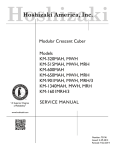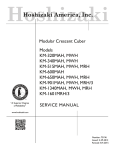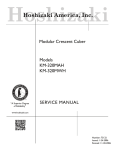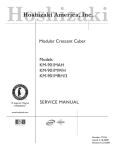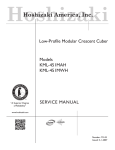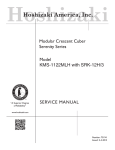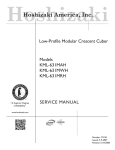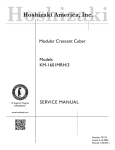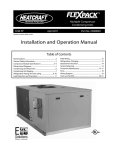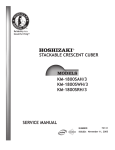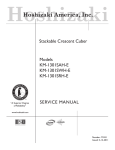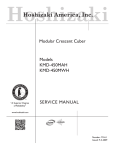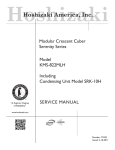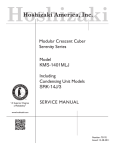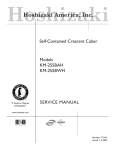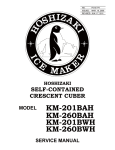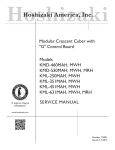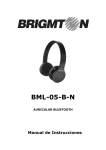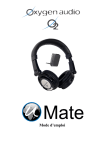Download Service Manual
Transcript
Hoshizaki
Hoshizaki America, Inc.
Modular Crescent Cuber
Models
KM-320MAH-E
KM-515MAH-E
KM-650MAH-E
“A Superior Degree
of Reliability”
SERVICE MANUAL
www.hoshizaki.com
89/336
73/23
Number: 73170
Issued: 11-13-2008
Revised: 3-22-2012
WARNING
Only qualified service technicians should install and service the icemaker. To
obtain the name and phone number of your local Hoshizaki Certified Service
Representative, visit www.hoshizaki-europe.com. No service should be undertaken
until the technician has thoroughly read this Service Manual. Failure to service and
maintain the icemaker in accordance with this manual will adversely affect safety,
performance, component life, and warranty coverage and may result in costly water
damage. Proper installation is the responsibility of the installer. Product failure or
property damage due to improper installation is not covered under warranty.
Hoshizaki provides this manual primarily to assist qualified service technicians in the
service and maintenance of the icemaker. Should the reader have any questions or
concerns which have not been satisfactorily addressed, please call the appropriate
Hoshizaki Service Office:
UK/Ireland - Hoshizaki UK
TEL : +44 (0)845 456 0585
FAX: +44 (0)132 283 8331
Holland - Hoshizaki Europe
TEL : +31 (0)20 6918499
FAX: +31 (0)20 6918768
Belgium/Luxemburg - Hoshizaki Belgium
TEL : +32 (0)2 7123030
FAX: +32 (0)2 7123031
Germany/Switzerland/Austria - Hoshizaki Deutschland
TEL : +49 (0)2154 92810
FAX: +49 (0)2154 928128
France - Hoshizaki France
TEL : +33 (0)1 48639380
FAX: +33 (0)1 48639388
Other countries - Hoshizaki Europe
TEL: +31 (0)20 6918499
FAX: +31 (0)20 6918768
Web Site: www.hoshizaki-europe.com
NOTE: To expedite assistance, all correspondence/communication MUST include the following information:
• Model Number ________________________
• Serial Number ________________________
• Complete and detailed explanation of the problem.
2
IMPORTANT
This manual should be read carefully before the icemaker is serviced. Read
the warnings and guidelines contained in this booklet carefully as they provide
essential information for the continued safe use, service, and maintenance of the
icemaker. Retain this booklet for any further reference that may be necessary.
CONTENTS
Important Safety Information.................................................................................................. 5
I. Specifications....................................................................................................................... 7
A. KM-320MAH-E .............................................................................................................. 7
B. KM-515MAH-E............................................................................................................... 8
C. KM-650MAH-E............................................................................................................... 9
II. General Information.......................................................................................................... 10
A. Construction................................................................................................................. 10
1. KM-320MAH-E........................................................................................................ 10
2. KM-515MAH-E........................................................................................................11
3. KM-650MAH-E....................................................................................................... 12
B. Sequence of Operation................................................................................................ 13
1. Sequence Cycles and Shutdown............................................................................ 13
a) "E" Control Board .............................................................................................. 13
b) "G" Control Board ............................................................................................. 15
2. Sequence Flow Chart............................................................................................. 17
a) "E" Control Board: ............................................................................................. 17
b) "G" Control Board: ............................................................................................ 18
C. Control Board............................................................................................................... 19
1. Control Board Layout.............................................................................................. 20
a) "E" Control Board ............................................................................................. 20
b) "G" Control Board ............................................................................................ 21
2. LED Lights and Audible Alarm Safeties.................................................................. 22
a) "E" Control Board ............................................................................................. 22
b) "G" Control Board ............................................................................................ 23
3. Controls and Adjustments....................................................................................... 24
a) Default Dip Switch Settings................................................................................ 24
b) Harvest Timer (S4 dip switch 1 & 2).................................................................. 25
c) Pump-Out Timer (S4 dip switch 3 & 4)............................................................... 25
d) Pump-Out Frequency Control (S4 dip switch 5 & 6).......................................... 26
e) Bin Control Selector/Harvest Pump Timer (S4 dip switch 7).............................. 26
f) Factory Use (S4 dip switch 8)............................................................................. 27
g) Freeze Timer (S4 dip switch 9 & 10).................................................................. 27
h) Float Switch Selector (S5 dip switch 1): "G" Control Board............................... 28
i) Refill Counter (S5 dip switch 2 through 5): "G" Control Board............................ 28
D. Control Switch.............................................................................................................. 28
3
III. Technical Information....................................................................................................... 29
A. Water Circuit and Refrigeration Circuit......................................................................... 29
B. Wiring Diagram............................................................................................................. 30
1. Thermostatic Bin Control ........................................................................................ 30
2. Mechanical Bin Control ......................................................................................... 31
C. Performance Data........................................................................................................ 32
1. KM-320MAH-E........................................................................................................ 32
2. KM-515MAH-E....................................................................................................... 33
3. KM-650MAH-E....................................................................................................... 34
IV. Service Diagnosis............................................................................................................ 35
A. Diagnostic Procedure................................................................................................... 35
B. Control Board Check.................................................................................................... 39
C. Bin Control Check........................................................................................................ 40
1. Thermostatic Bin Control Check ............................................................................. 40
2. Mechanical Bin Control Check and Cleaning ........................................................ 41
a) Mechanical Bin Control Check........................................................................... 41
b) Mechanical Bin Control Cleaning....................................................................... 42
D. Float Switch Check and Cleaning................................................................................ 43
1. Float Switch Check................................................................................................. 43
2. Float Switch Cleaning............................................................................................. 44
E. Thermistor Check......................................................................................................... 45
F. Diagnostic Charts......................................................................................................... 46
1. No Ice Production.................................................................................................... 46
2. Freeze-Up............................................................................................................... 47
3. Low Ice Production................................................................................................. 49
V. Replacement of Components........................................................................................... 50
A. Service for Refrigerant Lines........................................................................................ 50
1. Refrigerant Recovery.............................................................................................. 50
2. Brazing................................................................................................................... 51
3. Evacuation and Recharge (R-404A)....................................................................... 52
B. Important Notes for Component Replacement............................................................. 53
VI. Cleaning and Maintenance ............................................................................................. 54
A. Cleaning and Sanitizing Instructions............................................................................ 54
1. Cleaning Procedure................................................................................................. 55
2. Sanitizing Procedure - Following Cleaning Procedure............................................ 56
B. Maintenance................................................................................................................. 57
C. Preparing the Icemaker for Periods of Non-Use........................................................... 58
VII. Disposal.......................................................................................................................... 59
4
Important Safety Information
Throughout this manual, notices appear to bring your attention to situations which could
result in death, serious injury, damage to the icemaker, or damage to property.
WARNING Indicates a hazardous situation which could result in death or
serious injury.
NOTICE
Indicates a situation which could result in damage to the
icemaker or property.
IMPORTANT
Indicates important information about the use and care of the
icemaker.
WARNING
This icemaker should be destined only to the use for which it has been expressly
conceived. Any other use should be considered improper and therefore dangerous.
The manufacturer cannot be held responsible for injury or damage resulting from
improper, incorrect, and unreasonable use. Failure to service and maintain the
icemaker in accordance with this manual will adversely affect safety, performance,
component life, and warranty coverage and may result in costly water damage.
To reduce the risk of death, electric shock, serious injury, or fire, follow basic
precautions including the following:
• Only qualified service technicians should install and service this icemaker.
• Electrical connection must meet national, state, and local electrical code
requirements. Failure to meet these code requirements could result in death,
electric shock, serious injury, fire, or severe damage to equipment.
• This icemaker requires an independent power supply of proper capacity. See the
nameplate for electrical specifications. Failure to use an independent power supply
of proper capacity can result in a tripped breaker, blown fuses, damage to existing
wiring, or component failure. This could lead to heat generation or fire.
• THE ICEMAKER MUST BE EARTHED (GROUNDED). 220-240VAC UK and the
Republic of Ireland: This appliance is equipped with a non‑rewirable BSI BS-1363
to reduce the risk of potential
three‑prong 13A fused earthing (grounding) plug
shock hazards. It must be plugged into a properly earthed (grounded), independent
3-prong mains socket. If the mains socket is not compatible, it is your personal
responsibility to have a qualified electrician replace it with a properly earthed
(grounded), independent, compatible 3-prong mains socket. Do not remove the
earth (ground) prong or fuse from the plug and do not use an adapter plug. The
BSI BS-1363 three‑prong 13A fused earthing (grounding) plug must never be used
without a fuse cover being fitted. Failure to follow these instructions may result in
death, electric shock, or fire.
• 220-240VAC Continental: If the power cord and/or non‑rewirable plug should need
to be fitted or replaced, it should only be done by a qualified service technician.
Failure to follow these instructions may result in death, electric shock, or fire.
• To reduce the risk of electric shock, do not touch the control switch or plug with
damp hands.
5
WARNING, continued
• Before servicing the icemaker, move the control switch to the "OFF" position.
Unplug the icemaker from the mains socket.
• Do not use an extension cord.
• Do not use an icemaker with a damaged power cord. The power cord should not be
altered, jerked, bundled, weighed down, pinched, or tangled. Such actions could
result in electric shock or fire. To unplug the icemaker, be sure to pull the plug, not
the cord, and do not jerk the cord.
• The GREEN/YELLOW earth (ground) wire in the factory-installed power cord is
connected to the icemaker. If it becomes necessary to remove or replace the
power cord, be sure to connect the power cord's earth (ground) wire.
• Do not make any alterations to the icemaker. Alterations could result in electric
shock, injury, fire, or damage to the icemaker.
• This appliance is not intended for use by persons (including children) with reduced
physical, sensory, or mental capabilities, or lack of experience and knowledge,
unless they have been given supervision or instruction concerning use of the
appliance by a person responsible for their safety.
• Children should be properly supervised around this appliance.
• Do not climb, stand, or hang on the icemaker or allow children or animals to do so.
Serious injury could occur or the icemaker could be damaged.
• Do not use combustible spray or place volatile or flammable substances near the
icemaker. They might catch fire.
• Keep the area around the icemaker clean. Dirt, dust, or insects in the icemaker
could cause harm to individuals or damage to the icemaker.
NOTICE
• Follow the instructions in this manual carefully to reduce the risk of costly water
damage.
• In areas where water damage is a concern, install in a contained area with a floor
drain.
• Install the icemaker in a location that stays above freezing. Normal operating
ambient temperature must be within 45°F to 100°F (7°C to 38°C).
• Do not leave the icemaker on during extended periods of non-use, extended
absences, or in sub-freezing temperatures. To properly prepare the icemaker for
these occasions, follow the instructions in "VI.C. Preparing the Icemaker for Periods
of Non-Use."
• Do not place objects on top of the icemaker.
• The storage bin is for ice use only. Do not store anything else in the storage bin.
6
I. Specifications
A. KM-320MAH-E
AC SUPPLY VOLTAGE
AMPERAGE
MINIMUM CIRCUIT AMPACITY
MAXIMUM FUSE SIZE
APPROXIMATE ICE PRODUCTION
PER 24 HR.
lbs./day (kg/day)
Reference without *marks
FOR THE EUROPEAN MARKET
ICE CAPACITY lbs./day (kg/day)
SHAPE OF ICE
ICE PRODUCTION PER CYCLE
APPROXIMATE STORAGE CAPACITY
ELECTRIC & WATER CONSUMPTION
ELECTRIC W (kWH/100 lbs.)
WATER gal./24HR (gal./100 lbs.)
EXTERIOR DIMENSIONS (WxDxH)
EXTERIOR FINISH
WEIGHT
CONNECTIONS - ELECTRIC
- WATER SUPPLY
- DRAIN
CUBE CONTROL SYSTEM
HARVESTING CONTROL SYSTEM
ICE MAKING WATER CONTROL
COOLING WATER CONTROL
BIN CONTROL SYSTEM
COMPRESSOR
CONDENSER
EVAPORATOR
REFRIGERANT CONTROL
REFRIGERANT CHARGE
DESIGN PRESSURE
P.C. BOARD CIRCUIT PROTECTION
COMPRESSOR PROTECTION
REFRIGERANT CIRCUIT PROTECTION
LOW WATER PROTECTION
ACCESSORIES -SUPPLIED
-REQUIRED
OPERATING CONDITIONS
220-240/50/1
3.5 A (5 Min. Freeze at 109°F/WT 59°F)
15 A
15 A
Ambient
WATER TEMP. (°F)
Temp. (°F)
50
70
70
*293 (133)
275 (125)
80
279 (127)
252 (114)
90
275 (125)
*232 (105)
100
273 (124)
228 (103)
10/10°C
346 (157)
20/15°C
303 (137)
Crescent Cube
8 lbs. (3.6 kg) 360pcs.
N/A
90/70°F
70/50°F
710 (7.3)
650(5.3)
52(22.2)
117(40.1)
22"x27-3/8"x30-5/16" (560x695x770 mm)
Stainless Steel, Galvanized Steel (Rear)
Net 153 lbs. (69 kg), Shipping 175 lbs. (79 kg)
Power Cord - Connection
Inlet
1/2" FPT
Outlet
3/4" FPT
3/8" OD Hard Tube
Float Switch
Hot Gas and Water, Thermistor and Timer
Timer Controlled. Overflow Pipe
N/A
Thermostatic or Mechanical Bin Control
Hermetic, Model ASE32C3E-CAZ-254
Air-Cooled , Fin and tube type
Vertical type, Stainless Steel and Copper
Thermostatic Expansion Valve
R404A, 1 lb. 4.3 oz. (575g)
High 467PSIG, Low 230PSIG
High Voltage Cut-out ( Internal )
Auto-reset Overload Protector ( Internal )
Auto-reset High Pressure Control Switch
Float Switch
N/A
Ice Storage Bin
VOLTAGE RANGE
AMBIENT TEMP.
WATER SUPPLY TEMP.
WATER SUPPLY PRESSURE
90
255 (116)
234 (106)
213 (97)
196 (89)
30/25°C
236 (107)
198 - 254 V
45 -100° F
45 - 90° F
10 - 113 PSIG
Note: We reserve the right to make changes in specifications and design without prior
notice.
7
B. KM-515MAH-E
AC SUPPLY VOLTAGE
AMPERAGE
MINIMUM CIRCUIT AMPACITY
MAXIMUM FUSE SIZE
APPROXIMATE ICE PRODUCTION
PER 24 HR.
lbs./day ( kg/day )
Reference without *marks
FOR THE EUROPEAN MARKET
ICE CAPACITY
lbs./day ( kg/day )
SHAPE OF ICE
ICE PRODUCTION PER CYCLE
APPROXIMATE STORAGE CAPACITY
ELECTRIC & WATER CONSUMPTION
ELECTRIC W (kWH/100 lbs.)
WATER gal./24HR (gal./100 lbs.)
EXTERIOR DIMENSIONS (WxDxH)
EXTERIOR FINISH
WEIGHT
CONNECTIONS - ELECTRIC
- WATER SUPPLY
- DRAIN
CUBE CONTROL SYSTEM
HARVESTING CONTROL SYSTEM
ICE MAKING WATER CONTROL
COOLING WATER CONTROL
BIN CONTROL SYSTEM
COMPRESSOR
CONDENSER
EVAPORATOR
REFRIGERANT CONTROL
REFRIGERANT CHARGE
DESIGN PRESSURE
P.C. BOARD CIRCUIT PROTECTION
COMPRESSOR PROTECTION
REFRIGERANT CIRCUIT PROTECTION
LOW WATER PROTECTION
ACCESSORIES -SUPPLIED
-REQUIRED
OPERATING CONDITIONS
220-240/50/1
7.14 A ( 5 Min. Freeze AT 109°F / WT 59°F)
15A
15 A
Ambient
WATER TEMP. (°F)
Temp.(°F)
50
70
70
*513 (233)
482 (219)
80
490 (222)
442 (200)
90
482 (219)
*408 (185)
100
474 (215)
398 (181)
10/10°C
582 (264)
21/15°C
528 (239)
90
441 (200)
401 (182)
366 (166)
328 (149)
30/25°C
406 (184)
Crescent Cube
10.2 lbs. (4.6 kg) 480pcs.
N/A
90/70°F
70/50°F
1200(7.1)
1080(5.1)
108(26.5)
159(31.1)
22" x 27-3/8" x 30-5/16" (560 x 695 x 770 mm)
Stainless Steel, Galvanized Steel (Rear)
Net 151 lbs. (68 kg), Shipping 175 lbs. (79 kg)
Power Cord - Connection
Inlet
1/2" FPT
Outlet
3/4" FPT
3/8" OD Hard Tube
Float Switch
Hot Gas and Water, Thermistor and Timer
Time Controlled. Overflow Pipe
N/A
Thermostatic or Mechanical Bin Control
Hermetic, Model RST64C1E-CAZ-202
Air-Cooled , Fin and Tube Type
Vertical Type, Stainless Steel and Copper
Thermostatic Expansion Valve
R404A, 1 lb. 2.5 oz. L33 (525g)
High 467PSIG, Low 230PSIG
High Voltage Cut-Out ( Internal )
Auto-Reset Protector ( Internal )
Auto-Reset High-Pressure Switch
Float Switch
N/A
Ice Storage Bin
VOLTAGE RANGE
198-254VAC
AMBIENT TEMP.
45 -100° F
WATER SUPPLY TEMP.
45 - 90° F
WATER SUPPLY PRESSURE
10 - 113 PSIG
Note: We reserve the right to make changes in specifications and design without prior
notice.
8
C. KM-650MAH-E
AC SUPPLY VOLTAGE
AMPERAGE
MINIMUM CIRCUIT AMPACITY
MAXIMUM FUSE SIZE
APPROXIMATE ICE PRODUCTION
PER 24 HR.
lbs./day ( kg/day )
Reference without *marks
FOR THE EUROPEAN MARKET
ICE CAPACITY lbs./day (kg/day)
SHAPE OF ICE
ICE PRODUCTION PER CYCLE
APPROXIMATE STORAGE CAPACITY
ELECTRIC & WATER CONSUMPTION
ELECTRIC W (kWH/100 lbs.)
WATER gal./24HR (gal./100 lbs.)
EXTERIOR DIMENSIONS (WxDxH)
EXTERIOR FINISH
WEIGHT
CONNECTIONS - ELECTRIC
- WATER SUPPLY
- DRAIN
CUBE CONTROL SYSTEM
HARVESTING CONTROL SYSTEM
ICE MAKING WATER CONTROL
COOLING WATER CONTROL
BIN CONTROL SYSTEM
COMPRESSOR
CONDENSER
EVAPORATOR
REFRIGERANT CONTROL
REFRIGERANT CHARGE
DESIGN PRESSURE
P.C. BOARD CIRCUIT PROTECTION
COMPRESSOR PROTECTION
REFRIGERANT CIRCUIT PROTECTION
LOW WATER PROTECTION
ACCESSORIES -SUPPLIED
-REQUIRED
OPERATING CONDITIONS
220-240/50/1
6.8 A ( 5 Min. Freeze AT 109°F / WT 59°F)
15 A
15 A
Ambient
WATER TEMP. (°F)
Temp.(°F)
50
70
70
*653 (296)
610 (277)
80
620 (281)
554 (251)
90
610 (277)
*507 (230)
100
602 (273)
495 (225)
10/10°C
734 (333)
20/15°C
603 (274)
90
558 (253)
506 (229)
456 (207)
409 (186)
30/25°C
535 (243)
Crescent Cube
14 lbs. (6.4 kg) 720pcs.
N/A
90/70°F
70/50°F
1200(5.7)
1090(4.0)
94(18.5)
162(24.8)
22" x 27-3/8" x 37-7/16" (560 x 695 x 950 mm)
Stainless Steel, Galvanized Steel (Rear)
Net 169 lbs. (77 kg), Shipping 200 lbs. (91 kg)
Power Cord - Connection
Inlet
1/2" FPT
Outlet
3/4" FPT
3/8" OD Hard Tube
Float Switch
Hot Gas and Water, Thermistor and Timer
Time Controlled. Overflow Pipe
N/A
Thermostatic or Mechanical Bin Control
Hermetic, Model RST64C1E-CAZ-202
Air-Cooled , Fin and Tube Type
Vertical Type, Stainless Steel and Copper
Thermostatic Expansion Valve
R404A, 1 lb. 6.6 oz. (640g)
High 467PSIG, Low 230PSIG
High Voltage Cut-Out ( Internal )
Auto-Reset Protector ( Internal )
Auto-Reset High-Pressure Switch
Float Switch
N/A
Ice Storage Bin
VOLTAGE RANGE
198-254VAC
AMBIENT TEMP.
45 -100° F
WATER SUPPLY TEMP.
45 - 90° F
WATER SUPPLY PRESSURE
10 - 113 PSIG
Note: We reserve the right to make changes in specifications and design without prior
notice.
9
II. General Information
A. Construction
1. KM-320MAH-E
Main Transformer
(230V→115V)
Water Supply Pipe
Spray Tubes
Inlet Water Valve
Hot Gas Valve
Strainer
Control Switch
Condenser
Expansion Valve
U-0 and
Evaporator
Earlier
High-Pressure
Switch
U-1 and Later
Control Box
Power Cord with
Fused Plug
(250V, 13A fuse)
Thermistor
Fan Motor
Drier
Float Switch
Water Pump
Compressor
Mechanical Bin Control
Auxiliary Code U-1 and Later
10
Thermostatic Bin Control
Auxiliary Code U-0 and Earlier
2. KM-515MAH-E
Main Transformer
(230V→115V)
Expansion Valve
Spray Tubes
Water Supply Pipe
Hot Gas Valve
Strainer
Inlet Water Valve
Condenser
Control Switch
U-0 and Ear
Evaporator
U-1 and Later
lier
High-Pressure
Switch
Control Box
Power Cord with
Fused Plug
(250V, 13A fuse)
Thermistor
Fan Motor
Liquid Line Valve
Drier
Float Switch
Water Pump
Compressor
Mechanical Bin Control
Auxiliary Code U-2 and Later
11
Thermostatic Bin Control
Auxiliary Code U-1 and Earlier
3. KM-650MAH-E
Main Transformer
(230V→115V)
Water Supply Pipe
Spray Tubes
U-1 and Later
Inlet Water Valve
U-0 and Earlier
High-Pressure
Switch
Evaporator
Condenser
Control Box
Power Cord with
Fused Plug
(250V, 13A fuse)
Control Switch
Thermostatic
Expansion Valve
Strainer
Fan Motor
Thermistor
Hot Gas Valve
Float Switch
Drier
Water Pump
Compressor
Mechanical Bin Control
Auxiliary Code U-1 and Later
12
Thermostatic Bin Control
Auxiliary Code U-0 and Earlier
B. Sequence of Operation
1. Sequence Cycles and Shutdown
a) "E" Control Board
KM-320MAH-E and KM-650MAH-E Auxiliary Code U-0 and Earlier
KM-515MAH-E Auxiliary Code U-1 and Earlier
The steps in the sequence are as outlined below. When power is supplied, CB red
"POWER OK" LED comes on. There is a 5‑second delay before startup. Note that the
order of the component LEDs from the outer edge of CB is 1, 4, 3, 2.
(1) 1-Minute Fill Cycle
LED 4 is on. WV energizes and the fill period begins. After 1 minute, CB checks for
a closed F/S. If F/S is closed, the harvest cycle begins. If not, WV remains energized
through additional 1-minute fill cycles until water enters the water tank and F/S closes.
This serves as a low water safety to protect PM.
(2) Initial Harvest Cycle
LEDs 1, 4, and 2 are on. WV remains energized, Comp and HGV energize. CB
monitors the warming of the evaporator via the thermistor located on the suction line.
When the thermistor reaches 48°F (9°C), CB reads 3.9 kΩ from the thermistor and
turns harvest termination over to the adjustable harvest timer (S4 dip switch 1 & 2).
The harvest timer has settings of 60, 90, 120, and 180 seconds. The pump‑out timer
(S4 dip switch 3 & 4) acts in place of the harvest timer during cycles with a pump-out
(S4 dip switch 5 & 6). WV is energized during harvest for a maximum of 6 minutes or
the length of harvest, whichever is shorter. LED 4 turns off when WV de‑energizes.
The minimum total time allowed by CB for a complete harvest cycle is 2 minutes. At
the end of harvest, CB checks position of F/S and proceeds to the freeze cycle if it is
closed or calls for a 1-minute fill if it is open.
(3) Freeze Cycle
LED 1 is on. Comp remains energized, PM, FM, and LLV (KM‑515MAH-E) energize.
HGV and WV de-energize. For the first 5 minutes, CB will not terminate the freeze
cycle. This minimum 5-minute freeze time is short cycle protection for Comp. As ice
builds on the evaporator, the water level in the water tank lowers. Freeze continues
until F/S opens, provided the 5-minute minimum freeze timer has terminated.
13
(4) Pump-Out Cycle
LEDs 1, 3, and 2 are on. Comp remains energized. HGV energizes. WV energizes if
S4 dip switch 3 off and 4 on (LED 4 on). LLV (KM-515MAH-E) and FM de‑energize.
PM stops for 2 seconds then reverses for 10 or 20 seconds (S4 dip switch 3 & 4).
Water is removed from the bottom of the water tank through the check valve and
down the drain. At the same time, water flows through the small F/S tube to power
flush F/S. When the pump-out timer terminates, pump-out is complete.
The 1st pump‑out occurs after the 1st freeze cycle, then every 10th cycle
thereafter (KM-320MAH-E) or every cycle thereafter (KM-515MAH-E and
KM‑650MAH-E). The pump-out frequency control is factory set, and generally no
adjustment is required. However, the pump-out frequency control (S4 dip switch 5 &
6) can be set to have a pump-out occur every cycle, or every 2, 5, or 10 cycles. For
details, see "II.C.3.d) Pump‑Out Frequency Control (S4 dip switch 5 & 6)."
(5) Harvest Cycle
LEDs 1, 4, and 2 are on. Same as the initial harvest cycle. See "II.B.1.a)(2) Initial
Harvest Cycle."
Note: Icemaker continues to cycle until TBC is satisfied or power is turned off. The
icemaker always restarts at the 1-minute fill cycle.
(6) Shutdown
When ice contacts the thermostatic bulb (TBC switch open), TBC shuts down the
icemaker within 10 seconds. TBC is factory set, and generally no adjustment is
required. However, adjustment may be needed in some conditions, particularly at
higher altitude locations. NOTICE! Do not adjust S4 dip switch 7 out of the factory
default position. This dip switch must be left in the factory default position or
this icemaker will not operate correctly.
Legend: CB–control board; Comp–compressor; FM–fan motor; F/S–float switch; HGV–hot
gas valve; LLV–liquid line valve (KM-515MAH-E); PM–pump motor; TBC–thermostatic bin control; WV–inlet water valve
14
b) "G" Control Board
KM-320MAH-E and KM-650MAH-E Auxiliary Code U-1 and Later
KM-515MAH-E Auxiliary Code U-2 and Later
The steps in the sequence are as outlined below. When power is supplied, the red
"POWER OK" LED and the green "BC CLOSED" LED on CB turn on (If yellow
"BC OPEN" LED is on, the icemaker will not start. In this case clear ice away from BC
actuator paddle in the storage bin area). A 5-second delay occurs at startup. Note that
the order of the green sequence LEDs from the outer edge of the board is 1, 4, 3, 2.
(1) 1-Minute Fill Cycle
LED 4 is on. WV energizes and the fill period begins. After 1 minute, CB checks for
a closed F/S. If F/S is closed, the harvest cycle begins. If not, WV remains energized
through additional 1-minute fill cycles until water enters the water tank and F/S closes.
This serves as a low water safety to protect PM.
(2) Initial Harvest Cycle
LEDs 1, 4, and 2 are on. WV remains energized, Comp and HGV energize. CB
monitors the warming of the evaporator via the thermistor located on the suction line.
When the thermistor reaches 48°F (9°C), CB reads 3.9 kΩ from the thermistor and
turns harvest termination over to the adjustable harvest timer (S4 dip switch 1 & 2).
The harvest timer has settings of 60, 90, 120, and 180 seconds. The pump‑out timer
(S4 dip switch 3 & 4) acts in place of the harvest timer during cycles with a pump-out
(S4 dip switch 5 & 6). WV is energized during harvest for a maximum of 6 minutes
or the length of harvest, whichever is shorter. NOTICE! Do not adjust S4 dip switch
7 out of the factory default position. This dip switch must be left in the factory
default position or this icemaker will not operate correctly. For details, see
"II.C.3.e) Bin Control Selector/Harvest Pump Timer (S4 dip switch 7)." LED 4 turns
off when WV de‑energizes. The minimum total time allowed by CB for a complete
harvest cycle is 2 minutes. At the end of harvest, CB checks position of F/S and
proceeds to the freeze cycle if it is closed or calls for a 1-minute fill if it is open.
(3) Freeze Cycle
LED 1 is on. Comp remains energized, PM, FM, and LLV (KM‑515MAH-E) energize.
HGV and WV de-energize. For the first 5 minutes, CB will not terminate the freeze
cycle. At the end of 5 minutes, F/S assumes control of the freeze cycle. As ice builds
on the evaporator, the water level in the water tank lowers. Freeze continues until
F/S opens, provided the 5-minute minimum freeze timer has terminated. There is a
15 second delay before CB acknowledges an open F/S.
15
(4) Pump-Out Cycle
LEDs 1, 3, and 2 are on. Comp remains energized. HGV energizes. WV energizes if
S4 dip switch 3 off and 4 on (LED 4 on). LLV (KM-515MAH-E) and FM de‑energize.
PM stops for 2 seconds then reverses for 10 or 20 seconds (S4 dip switch 3 & 4).
Water is removed from the bottom of the water tank through the check valve and
down the drain. At the same time, water flows through the small F/S tube to power
flush F/S. When the pump-out timer terminates, pump-out is complete.
The 1st pump‑out occurs after the 11th freeze cycle, then every 10th cycle thereafter
(KM-320MAH-E) or every cycle thereafter (KM-515MAH-E and the KM-650MAH-E).
The pump-out frequency control is factory set, and generally no adjustment is
required. However, the pump-out frequency control (S4 dip switch 5 & 6) can be set
to have a pump-out occur every cycle, or every 2, 5, or 10 cycles. For details, see
"II.C.3.d) Pump‑Out Frequency Control (S4 dip switch 5 & 6)."
"G" Control Board Settings
S4 Dip Switch Setting
No. 5
No. 6
Pump-Out
Frequency
OFF
OFF
Every cycle
After 2nd freeze cycle
ON
OFF
Every 2 cycles
After 3rd freeze cycle
OFF
ON
Every 5 cycles
After 6th freeze cycle
ON
ON
Every 10 cycles
After 11th freeze cycle
1st Pump-Out
(5) Harvest Cycle
LEDs 1, 4, and 2 are on. Same as the initial harvest cycle. See "II.B.1.b)(2) Initial
Harvest Cycle."
Note: Icemaker continues to cycle until MBC is satisfied or power is turned off. The
icemaker always restarts at the 1-minute fill cycle.
(6) Shutdown
When MBC is activated (MBC open), the yellow "BC OPEN" LED comes on. The
icemaker then shuts down as outlined in the table below.
Cycle at
Shutdown
Mechanical Bin
Control Activation
Fill Cycle
15 seconds after activation.
Harvest Cycle
At the end of the harvest cycle, or up to 15 seconds into the freeze cycle if activated
at the end of the harvest cycle.
Freeze Cycle
15 seconds after activation if activated at least 15 seconds before the 5-minute short
cycle protection timer terminates. Otherwise, at the end of the next harvest cycle.
Legend: CB–control board; Comp–compressor; FM–fan motor; F/S–float switch; HGV–hot gas valve; LLV–liquid line valve (KM-515MAH-E); MBC–mechanical bin
control; PM–pump motor; WV–inlet water valve
16
17
1 to 3-min. harvest
timer in control
(S4 dip switch 1 & 2)
F/S check
Thermistor
temperature
WV continues
Comp energized reaches 48°F (9°C) (3.9
HGV energized kΩ or less). Harvest
timer starts (1 to 3 min.).
F/S open
F/S closed
Thermistor
in control
• Maximum inlet water valve time: 6 min.
• Maximum harvest time: 20 min.
2. Harvest Cycle
Ice contacts TBC bulb
TBC
Operation
F/S in control
a) "E" Control Board:
KM-320MAH-E and KM-650MAH-E Auxiliary Code U-0 and Earlier
KM-515MAH-E Auxiliary Code U-1 and Earlier
The "WASH" position on the control switch is used when cleaning and sanitizing the icemaker. When in
the "WASH" position, power is supplied to the pump motor. With the cleaning valve closed, the cleaner and
sanitizer flow over the outside of the evaporator plate assembly. With the cleaning valve open, the cleaner and
sanitizer flow over both the outside and the inside of the evaporator plate assembly.
Note: Close the cleaning valve after cleaning and sanitizing are complete, otherwise the icemaker will not
restart when the control switch is placed in the "ICE" position.
Components Energized when the Control Switch is in the "WASH" Position
To 1 above
Comp continues
HGV energized
WV energized (dependent on pump-out timer setting)
PM de-energizes for 2 sec.,
then reverses for 10/20 sec.
FM de-energized
LLV de-energized
• Factory set for every
10th cycle (S4 dip
switch 5 & 6)
• Pump motor stops
for 2 sec., then
reverses for 10/20
sec. (S4 dip switch
3 & 4)
4. Pump-Out Cycle
Legend:
Comp–compressor
FM–fan motor
F/S–float switch
HGV–hot gas valve
LLV–liquid line valve (KM-515MAH-E)
PM–pump motor
TBC–themostatic bin control
WV–inlet water valve
F/S open or
freeze timer
Comp continues
terminates
FM energized
LLV energized
PM energized
HGV de-energized
WV de-energized
F/S closed
5-min.
minimum
freeze timer in
control
• Minimum freeze time: 5 min.
• Maximum freeze time: freeze
timer setting
(S4 dip switch 9 & 10)
3. Freeze Cycle
No ice touching
TBC bulb.
Icemaker starts at
"1. 1-Minute Fill Cycle."
3. Ice Level Lowered
TBC closed
All components de-energized.
2. Icemaker Off
TBC open
All components
de-energized
Within 10 sec.
after ice contacts TBC bulb, icemaker shuts
down.
1. Bin Full
If F/S is open, Comp stops and cycle returns to 1-min. fill.
F/S open
WV energized
F/S check
1. 1-Minute
Fill Cycle
Shutdown
and Restart
Startup
Cycle
Steps
"E" Control Board Sequence Flow Chart
KM-320MAH-E, KM-515MAH-E, KM-650MAH-E
2. Sequence Flow Chart
18
F/S open
To 1 above
Icemaker starts at
"1. 1-Minute Fill Cycle."
3. Ice Level Lowered
Yellow "BC OPEN" LED continues. MBC closed
All components de‑energized
(MBC actuator paddle disengaged)
Green "BC CLOSED" LED on
Yellow "BC OPEN" LED off
All components de-energized.
2. Icemaker Off
Comp continues
HGV energized
WV energized (dependent on pump-out timer setting)
PM de-energizes for 2 sec.,
then reverses for 10/20 sec.
FM de-energized
LLV de-energized
• Factory set for every
10th cycle (S4 dip
switch 5 & 6)
• Pump motor stops
for 2 sec., then
reverses for 10/20
sec. (S4 dip switch
3 & 4)
4. Pump-Out Cycle
The "WASH" position on the control switch is used when cleaning and sanitizing the icemaker. When in the "WASH"
position, power is supplied to the pump motor. With the cleaning valve closed, the cleaner and sanitizer flow over the
outside of the evaporator plate assembly. With the cleaning valve open, the cleaner and sanitizer flow over both the
outside and the inside of the evaporator plate assembly.
Note: Close the cleaning valve after cleaning and sanitizing are complete, otherwise the icemaker will not restart
when the control switch is placed in the "ICE" position.
Components Energized when the Control Switch is in the "WASH" Position
MBC open (MBC actuator paddle engaged)
Green "BC CLOSED" LED off
Yellow "BC OPEN" LED on
F/S in control
F/S open or
Comp continues
freeze timer
FM energized
terminates
LLV energized
PM energized
HGV de-energized
WV de-energized
F/S closed
5-min.
minimum
freeze timer
in control
• Minimum freeze time: 5 min.
• Maximum freeze time: freeze
timer setting
(S4 dip switch 9 & 10)
3. Freeze Cycle
Shutdown Delay:
• Fill Cycle–15 sec. after activation.
• Harvest Cycle–At the end of the harvest cycle, or up to 15 sec. into the freeze cycle if activated at the end of the harvest cycle.
• Freeze Cycle–15 sec. after activation if activated at least 15 sec. before the 5-min. short cycle protection timer terminates
Otherwise, at the end of the next harvest cycle.
1. Bin Full
Legend:
Comp–compressor
FM–fan motor
F/S–float switch
HGV–hot gas valve
LLV–liquid line valve (KM-515MAH-E)
MBC–mechanical bin control
PM–pump motor
WV–inlet water valve
MBC Operation
F/S check
1 to 3-min. harvest timer in
control (S4 dip switch 1 & 2)
WV continues
Comp energized Thermistor temperature reaches
48°F (9°C) (3.9 kΩ or less).
HGV energized
Harvest timer starts (1 to 3 min.).
F/S closed
Thermistor
in control
• Maximum inlet water valve time: 6 min.
• Maximum harvest time: 20 min.
If F/S is open, Comp stops and cycle returns to 1-min. fill.
F/S open
WV energized
F/S check
1. 1-Minute
Fill Cycle
Shutdown
and Restart
Startup
Cycle
Steps
2. Harvest Cycle
"G" Control Board Sequence Flow Chart
KM-320MAH-E, KM-515MAH-E, KM-650MAH-E
b) "G" Control Board:
KM-320MAH-E and KM-650MAH-E Auxiliary Code U-1 and Later
KM-515MAH-E Auxiliary Code U-2 and Later
C. Control Board
• A Hoshizaki exclusive control board is employed in Hoshizaki icemakers.
• All models are pretested and factory adjusted.
• For a control board check procedure, see "IV.B. Control Board Check."
NOTICE
• Fragile, handle very carefully.
• The control board contains integrated circuits, which are susceptible to failure
due to static discharge. It is especially important to touch the metal part of the
icemaker when handling or replacing the control board.
• Do not touch the electronic devices on the control board or the back of the control
board.
• Do not change wiring and connections. Do not misconnect terminals.
• Do not short out power supply to test for voltage.
• Always replace the whole control board assembly if it goes bad.
19
1. Control Board Layout
a) "E" Control Board
KM-320MAH-E and KM-650MAH-E Auxiliary Code U-0 and Earlier
KM-515MAH-E Auxiliary Code U-1 and Earlier
"E" Control Board
• "ALARM RESET" Button
• "OUTPUT TEST" Button
(used to test relays on control board)
• S4 Dip Switch
• Freeze Timer
LED (yellow)
• K3 (white) Connector
Harvest Control
(thermistor)
• Harvest Backup
Timer LED (orange)
• K4 (red) Connector
Mechanical Bin Control
(open on thermostatic bin
control application)
• Alarm Buzzer
• Power LED (red)
(lights when
10.5VAC is
supplied to
K2 connector)
Microprocessor
(board revision level
indicated by last
2 digits on label)
• Relay LEDs
(4) (indicate which
relays are energized
and which K1
connector pins are
energized
• K5 (black) Connector
Float Switch
• Part Number
• K1 Connector
Pins #1 through #10
#1, 9 Magnetic Contactor
#2 Hot Gas Valve
#3 Fan Motor (all)
Liquid Line Valve
(KM-515MAH-E)
#4 Pump Motor (icemaking)
#5 Pump Motor (pump-out)
#6 Inlet Water Valve
#7, 10 Power Supply Voltage
#8 Open
• LED 2 (X2 Relay)
LED 2 on:
K1 Connector Pin #2
LED 2 off:
K1 Connector Pin #3
• LED 3 (X3 Relay)
LED 3 on:
K1 Connector Pin #5
LED 3 off:
K1 Connector Pin #4
(energized in freeze)
Switch for "C" control board
and "ALPINE" control board
(service control board only)
Set to "ALP" for icemakers
covered in this manual.
• LED 4 (X4 Relay)
K1 Connector Pin #6
• LED 1 (X1 Relay)
K1 Connector Pin #1, #9
• K2 Connector
Control Transformer
(10.5VAC)
"E" Control Board
Part Number
20
2A1410-02
b) "G" Control Board
KM-320MAH-E and KM-650MAH-E Auxiliary Code U-1 and Later
KM-515MAH-E Auxiliary Code U-2 and Later
"G" Control Board
• Bin Control Switch
Closed LED (green)
(on continuously in thermostatic bin control application)
• "ALARM RESET" Button
• S4 Dip Switch
• "OUTPUT TEST" Button
(used to test relays on control board)
• K3 (white) Connector
Harvest Control
(thermistor)
• Bin Control Switch
Open LED (yellow)
(mechanical bin control application only)
• Part Number
• K4 (red) Connector
Mechanical Bin Control or
K4 Jumper (thermostatic
bin control application)
• S5 Dip Switch
• Alarm Buzzer
• Power LED (red)
(lights when
10.5VAC is
supplied to
K2 connector)
• K5 (black) Connector
Float Switch
• Relay LEDs
(4) (indicate which
relays are energized
and which K1
connector pins are
energized
Label
(control board revision
level indicated on label
on side of relay)
• K1 Connector
• LED 2 (X2 Relay)
LED 2 on:
K1 Connector Pin #2
LED 2 off:
K1 Connector Pin #3
Pins #1 through #10
#1, 9 Compressor Relay
#2 Hot Gas Valve
#3 Fan Motor (all)
Liquid Line Valve
(KM-515MAH-E)
#4 Pump Motor (icemaking)
#5 Pump Motor (pump-out)
#6 Inlet Water Valve
#7, 10 Power Supply Voltage
#8 Open
• LED 3 (X3 Relay)
LED 3 on:
K1 Connector Pin #5
LED 3 off:
K1 Connector Pin #4
(energized in freeze)
• LED 4 (X4 Relay)
K1 Connector Pin #6
• LED 1 (X1 Relay)
K1 Connector Pin #1, #9
• K2 Connector
Control Transformer
(10.5VAC)
"G" Control Board
Part Number 2A3792-01
21
2. LED Lights and Audible Alarm Safeties
a) "E" Control Board
KM-320MAH-E and KM-650MAH-E Auxiliary Code U-0 and Earlier
KM-515MAH-E Auxiliary Code U-1 and Earlier
At startup, a 5-second delay occurs while the control board conducts an internal timer
check. A beep occurs when power is turned off. The red LED indicates proper control
voltage and remains on unless a control voltage problem occurs. The green LEDs
1 through 4 energize and sequence from initial startup as listed in the table below.
Note that the order of the LEDs from the outer edge of the control board is 1, 4, 3, 2.
For details, see "II.B.1.a) "E" Control Board."
Sequence Step
LED
1-Minute Fill Cycle 4
Harvest Cycle
1, 4, 2
Freeze Cycle
1
Pump-Out Cycle
1, 4*, 3, 2
Energized
Components
WV
Comp, FMR, HGV, WV
Comp, FM/FMR, PM
LLV (KM-515MAH-E)
Comp, FMR, HGV, PM,
WV*
Time LEDs are On
Max.
Avg.
1 minute
2 minutes 20 minutes 3 to 5 minutes
5 minutes freeze timer 30 to 35 minutes
setting
10 seconds 20 seconds *pump-out timer
setting
Min.
The built in safeties shut down the icemaker and have alarms as listed below.
No. of Beeps
Type of Alarm
(every 3 sec.)
1
High Evaporator Temp.
(temperature > 127°F)
(53°C)
2
Harvest Backup Timer
(harvest > 20 min. for two cycles
in a row)
3
Freeze Timer
(freeze > specified setting for
two cycles in a row)
Notes
Check for harvest problem (stuck HGV or relay), hot
water entering icemaker, or shorted thermistor.
Orange LED marked H TIMER lights up. Check for open
thermistor, HGV not opening, TXV or LLV leaking by, low
charge, or inefficient Comp.
Yellow LED marked F TIMER lights up. Check for F/S
stuck closed (up), WV leaking by, HGV leaking by, PM
not pumping, TXV not feeding properly, LLV not opening,
low charge, or inefficient Comp.
To reset the above safeties, press the "ALARM RESET" button with the power supply on.
6
Low Voltage
Red LED will turn off if voltage protection operates.
(92Vac±5% or less)
The control voltage safeties automatically reset when
voltage is corrected.
7
High Voltage
(147Vac±5% or more)
Legend: Comp–compressor; FM–fan motor; FMR–fan motor remote; F/S–float switch;
HGV–hot gas valve; LLV–liquid line valve (KM-515MAH-E); PM–pump motor;
TXV–thermostatic expansion valve; WV–inlet water valve
22
b) "G" Control Board
KM-320MAH-E and KM-650MAH-E Auxiliary Code U-1 and Later
KM-515MAH-E Auxiliary Code U-2 and Later
At startup, a 5-second delay occurs while the control board conducts an internal timer
check. A beep occurs when the control switch is moved to the "ICE" position. The
red LED indicates proper control voltage and remains on unless a control voltage
problem occurs. The green LEDs 1 through 4 energize and sequence from initial
startup as listed in the table below. Note that the order of the LEDs from the outer
edge of the control board is 1, 4, 3, 2. For details, see "II.B.1.b) "G" Control Board."
Sequence Step
1-Minute Fill Cycle
Harvest Cycle
Harvest Pump Timer
(not used on these
models)
Freeze Cycle
Pump-Out Cycle
LED
4
1, 4, 2
1, 3, 2
Energized
Components
WV
Comp, FMR, HGV, WV
Comp, FMR, HGV, PM
1
Comp, FM/FMR, PM,
LLV (KM-515MAH-E)
1, 4*, 3, 2 Comp, FMR, HGV, PM,
WV*
Time LEDs are On
Min.
Max.
Avg.
1 minute
2 minutes 20 minutes 3 to 5 minutes
0 seconds 50 seconds harvest pump timer
setting
5 minutes
freeze timer 30 to 35 minutes
setting
10 seconds 20 seconds *pump‑out timer
setting
The built-in safeties shut down the icemaker and have alarms as listed below.
No. of Beeps
Type of Alarm
Notes
(every 3 sec.)
1
High Evaporator Temp.
Check for harvest problem (stuck HGV or relay), hot
(temperature > 127°F)
water entering icemaker, or shorted thermistor.
(53°C)
2
Harvest Backup Timer
Check for open thermistor, HGV not opening, TXV or LLV
(harvest > 20 min. for two cycles leaking by, low charge, or inefficient Comp.
in a row)
3
Freeze Timer
Check for F/S stuck closed (up), WV leaking by, HGV
(freeze > freeze timer setting for leaking by, PM not pumping, TXV not feeding properly,
two cycles in a row)
LLV not opening, low charge, or inefficient Comp.
To reset the above safeties, press the "ALARM RESET" button with the power supply on.
6
Low Voltage
Red LED turns off if voltage protection operates.
(92Vac±5% or less)
The control voltage safeties automatically reset when
voltage is corrected.
7
High Voltage
(147Vac±5% or more)
Legend: Comp–compressor; FM–fan motor; FMR–fan motor remote; F/S–float switch;
HGV–hot gas valve; LLV–liquid line valve (KM-515MAH-E); PM–pump motor;
TXV–thermostatic expansion valve; WV–inlet water valve
23
3. Controls and Adjustments
NOTICE
Dip switches are factory set. Failure to maintain factory settings may adversely
affect performance and warranty coverage. For more information, contact your
Hoshizaki Service Center.
a) Default Dip Switch Settings
The dip switches are factory-adjusted to the following positions for both the "E" and "G"
control boards:
S4 Dip Switch No.
1
2
3
4
5
ON
6
7
8
9
ON OFF OFF ON
10
KM-320MAH-E
ON OFF OFF ON
ON
KM-515MAH-E
OFF OFF OFF OFF OFF OFF OFF OFF ON OFF
KM-650MAH-E
OFF OFF OFF OFF OFF OFF OFF OFF ON
ON
S5 Dip Switch (Do Not Adjust)
"G" Control Board
KM-320MAH-E
KM-515MAH-E
KM-650MAH-E
1
2
3
4
5
OFF OFF OFF OFF OFF
S5 Dip Switch
"G" Control Board Only
S4 Dip Switch
"E" and "G" Control Boards
Do Not Adjust
Factory Use (8)
Bin Control Selector (7) "E" Control Board
Harvest Pump Timer (7) "G" Control Board
(Do Not Adjust)
Pump-Out Frequency Control (5 & 6)
Pump-Out Timer (3 & 4)
Harvest Timer (1 & 2)
24
ON
1 2 3 4 5 6 7 8 9 10
ON
Freeze Timer (9 & 10)
1 2 3 4 5
Dip Switch No.
Refill Counter
(2 through 5)
Float Switch
Selector (1)
b) Harvest Timer (S4 dip switch 1 & 2)
The harvest timer starts counting when the thermistor reaches 48°F (9°C) at the
evaporator outlet and the control board reads 3.9 kΩ from the thermistor. The harvest
timer is factory set, and generally no adjustment is required. However, a setting longer
than the factory setting may be advised in cases where the flush provided at harvest
needs to be prolonged for extra cleaning. Before changing this setting, contact your
Hoshizaki Service Office for recommendations. Keep in mind that setting the harvest
timer to a longer setting decreases 24-hour production.
Note that the pump-out timer (S4 dip switch 3 & 4) acts in place of the harvest timer
during cycles with a pump out. For details, see "II.C.3.c) Pump-Out Timer (S4 dip switch
3 & 4)." On KM-515MAH-E and KM-650MAH‑E models, the harvest timer is only relevant
during the initial harvest cycle since a pump out occurs every cycle thereafter.
S4 Dip Switch Setting
No. 1
No. 2
Time
(seconds)
OFF
OFF
60
ON
OFF
90
OFF
ON
120
ON
ON
180
c) Pump-Out Timer (S4 dip switch 3 & 4)
NOTICE
On KM-515MAH-E and KM-650MAH-E models, never adjust the pump-out timer's
harvest timer (T2) for a time less than 150 seconds. Otherwise, the icemaker will
not perform properly.
When a pump-out is called for, the pump motor de-energizes after the preceding freeze
cycle. The pump motor energizes 2 seconds later in the reverse direction, taking water
from the bottom of the water tank and forcing pressure against the check valve seat
allowing water to go through the check valve and down the drain. At the same time, water
flows through the small tube to power flush the float switch. The pump motor drains the
water tank for the time determined by the pump-out timer. The pump‑out timer also acts
in place of the harvest timer during cycles with a pump-out. The pump-out timer is factory
set, and generally no adjustment is required. However, where water quality is bad and
the icemaker needs a longer pump-out time, the pump-out timer can be adjusted. The
pump‑out timer control can be set to pump-out for 10 or 20 seconds.
S4 Dip Switch Setting
Time (seconds)
No. 3
No. 4
T1
T2
Inlet Water
Valve
OFF
OFF
10
150
Closed
ON
OFF
10
180
Closed
OFF
ON
10
120
Open
ON
ON
20
180
Closed
T1: Time to drain the water tank
T2: Harvest timer at pump out
25
d) Pump-Out Frequency Control (S4 dip switch 5 & 6)
NOTICE
On KM-515MAH-E and KM-650MAH-E models: Do not adjust.
Adjustments to this setting may adversely affect performance and warranty coverage.
The pump-out frequency control is factory set to drain the water tank every 10 cycles
on the KM-320MAH-E and every cycle on the KM-515MAH-E and the KM-650MAH-E,
and generally no adjustment is required. However, where water quality is bad and the
icemaker needs a pump-out more often, the pump-out frequency can be adjusted. The
pump-out frequency control can be set to have a pump-out occur every cycle, or every
2, 5, or 10 cycles.
Timing of the first pump-out is dependent on the control board. "E" control board first
pump‑out is after the first freeze cycle. "G" control board first pump-out is dependent on
S4 dip switch 5 & 6. See the table below.
"E" & "G" Control Board
S4 Dip Switch Setting
1st Pump-Out
No. 5
No. 6
Pump-Out
Frequency
"E" Control Board
"G" Control Board
OFF
OFF
Every cycle
After 1st freeze cycle
After 2nd freeze cycle
ON
OFF
Every 2 cycles
After 3rd freeze cycle
OFF
ON
Every 5 cycles
After 6th freeze cycle
ON
ON
Every 10 cycles
After 11th freeze cycle
e) Bin Control Selector/Harvest Pump Timer (S4 dip switch 7)
Depending on the control board, S4 dip switch 7 is either a bin control selector or harvest
pump timer.
NOTICE
Do not adjust. This dip switch must be left in the factory default position or this
icemaker will not operate correctly.
(1) Bin Control Selector, "E" Control Board
KM-320MAH-E and KM-650MAH-E Auxiliary Code U-0 and Earlier
KM-515MAH-E Auxiliary Code U-1 and Earlier
Factory set for proper operation. Do not adjust. When set to the on position on a
icemaker with a thermostatic bin control, a 5-beep alarm sounds (open circuit) and the
icemaker does not operate.
"E" Control Board
S4 Dip Switch Setting
No. 7
Bin Control
ON
Mechanical
OFF
Thermostatic
26
(2) Harvest Pump Timer, "G" Control Board
KM-320MAH-E and KM-650MAH-E Auxiliary Code U-1 and Later
KM-515MAH-E Auxiliary Code U-2 and Later
Factory set for proper operation. Do not adjust. Depending on the harvest pump timer
setting, the pump motor energizes and runs the last 0 or 50 seconds of harvest. The
water valve is energized during harvest for a maximum of 6 minutes or the length
of harvest minus 0 or 50 seconds (determined by the harvest pump timer setting),
whichever is shorter. NOTICE! Do not adjust S4 dip switch 7 out of the factory
default position on this model. This dip switch must be left in the factory default
position or this icemaker will not operate correctly.
"G" Control Board
S4 Dip Switch Setting
No. 7
Pump Motor
Time (seconds)
ON
50
OFF
0
f) Factory Use (S4 dip switch 8)
Factory set for proper operation. Do not adjust. This must be left in the factory default
position.
g) Freeze Timer (S4 dip switch 9 & 10)
NOTICE
Adjust to proper specification, or the icemaker may not operate correctly.
The freeze timer setting determines the maximum allowed freeze time to prevent
possible freeze-up issues. Upon termination of the freeze timer, the control board initiates
the harvest cycle. After 2 consecutive timer terminations, the control board shuts the
icemaker down. In this case, see "IV.F.3. Low Ice Production" for possible solutions.
The freeze timer is factory set and no adjustment is required.
S4 Dip Switch Setting
No. 9
No. 10
Time
(minutes)
OFF
OFF
60
OFF
ON
50
ON
OFF
70
ON
ON
75
27
h) Float Switch Selector (S5 dip switch 1): "G" Control Board
NOTICE
Do not adjust. This must be left in the factory default position or the icemaker will
not operate correctly.
i) Refill Counter (S5 dip switch 2 through 5): "G" Control Board
NOTICE
Do not adjust. These must be left in the factory default position or the icemaker will
not operate correctly.
D. Control Switch
The control switch has three positions: "OFF" for power off, "ICE" for icemaking, and
"WASH" to activate the water pump when cleaning and sanitizing.
28
III. Technical Information
A. Water Circuit and Refrigeration Circuit
1. KM-320MAH-E, KM-515MAH-E, and KM-650MAH-E
Spray Tubes
Condenser
Inlet Water Valve
Drier
Evaporator
Water Supply
Fan
High-Pressure
Switch
Liquid Line Valve
(KM-515MAH-E)
Thermistor
Heat
Exchanger
Suction
Line
Strainer
Water Pump
Float Switch
Water
Tank
Discharge Line
Compressor
Freeze
Drain
Pump Out
Thermostatic Expansion Valve
Check Valve
Refrigeration Circuit
Water Circuit
29
Hot Gas
Valve
B. Wiring Diagram
* Pressure Switch
Cut-out
412±21 PSIG
Cut-in
327±21
PSIG
0
*
Transformer Output
10.5V at 115V
1. Thermostatic Bin Control
KM-320MAH-E and KM-650MAH-E Auxiliary Code U-0 and Earlier
KM-515MAH-E Auxiliary Code U-1 and Earlier
30
* Pressure Switch
Cut-out
412±21 PSIG
Cut-in
327±21
PSIG
0
*
Transformer Output
10.5V at 115V
2. Mechanical Bin Control
KM-320MAH-E and KM-650MAH-E Auxiliary Code U-1 and Later
KM-515MAH-E Auxiliary Code U-2 and Later
31
C. Performance Data
1. KM-320MAH-E
APPROXIMATE ICE
PRODUCTION PER 24 HR.
lbs./day kg./day
APPROXIMATE ELECTRIC
CONSUMPTION
watts
APPROXIMATE WATER
CONSUMPTION PER 24 HR.
gal./day m3/day
FREEZING CYCLE TIME
min.
HARVEST CYCLE TIME
min.
HEAD PRESSURE
PSIG
kg/cm2G
SUCTION PRESSURE
PSIG
kg/cm2G
AMBIENT TEMP.
(ºF/ºC)
70/21
80/27
90/32
100/38
70/21
80/27
90/32
100/38
70/21
80/27
90/32
100/38
70/21
80/27
90/32
100/38
70/21
50/10
293
279
133
127
275
273
125
124
WATER TEMP. (ºF/ºC)
70/21
275
125
252
114
232
228
650
663
668
105
103
90/32
255
234
116
106
213
196
97
89
673
686
710
668
691
710
710
710
663
117
103
98
0.44
0.39
0.37
98
73
52
0.37
0.28
0.19
89
73
47
0.34
0.28
0.18
76
0.29
51
0.19
43
0.16
80/27
90/32
100/38
34
36
37
37
5.8
37
42
47
47
4.9
39
42
47
48
4.5
5.1
4.9
3.9
3.8
2.8
2.8
3.8
2.7
2.5
70/21
80/27
90/32
210
229
235
14.8
16.1
16.5
235
268
295
16.5
18.8
20.7
253
276
308
17.8
19.4
21.7
100/38
233
16.4
298
21.0
320
22.5
70/21
80/27
90/32
56
57
57
3.9
4.0
4.0
57
59
60
4.0
4.1
4.2
58
60
61
4.1
4.2
4.3
100/38
57
4.0
60
4.2
62
4.4
TOTAL HEAT OF REJECTION FROM CONDENSER
5,400 BTU/h [AT 90ºF (32ºC) / WT 70ºF (21ºC)]
Note:
1. Pressure data is recorded at 5 minutes into freezing cycle. The data not in bold
should be used for reference only.
2. We reserve the right to make changes in specifications and design without prior
notice.
32
2. KM-515MAH-E
APPROXIMATE ICE
PRODUCTION PER 24 HR.
lbs./day kg./day
APPROXIMATE ELECTRIC
CONSUMPTION
watts
APPROXIMATE WATER
CONSUMPTION PER 24 HR.
gal./day m3/day
FREEZING CYCLE TIME
min.
HARVEST CYCLE TIME
min.
HEAD PRESSURE
PSIG
kg/cm2G
SUCTION PRESSURE
PSIG
2
kg/cm G
AMBIENT TEMP.
(ºF/ºC)
70/21
80/27
90/32
100/38
70/21
80/27
90/32
100/38
70/21
80/27
90/32
100/38
70/21
80/27
90/32
100/38
70/21
50/10
513
490
233
222
482
474
219
215
WATER TEMP. (ºF/ºC)
70/21
482
219
442
200
408
398
1080
1107
1115
125
80/27
90/32
100/38
200
182
366
328
166
149
1150
1189
1231
1115
1161
1200
1260
1207
1118
159
148
144
185
181
90/32
441
401
0.60
0.56
0.55
144
125
108
0.47
106
0.55
0.47
0.41
131
115
97
0.40
87
0.50
0.44
0.37
0.33
26
28
28
29
3.4
28
31
33
34
3.2
32
35
37
40
3.2
3.3
3.2
3.1
3.0
2.9
2.9
3.1
2.9
2.9
70/21
80/27
90/32
245
262
267
17.2
18.4
18.8
267
296
320
18.8
20.8
22.5
294
321
346
20.6
22.5
24.3
100/38
271
19.1
326
22.9
370
26.0
70/21
80/27
90/32
50
53
54
3.5
3.8
3.8
54
60
65
3.8
4.2
4.6
57
61
67
4.0
4.3
4.7
100/38
54
3.8
65
4.6
69
4.9
TOTAL HEAT OF REJECTION FROM CONDENSER
10,400 BTU/h [AT 90ºF (32ºC) / WT 70ºF (21ºC)]
Note:
1. Pressure data is recorded at 5 minutes into freezing cycle. The data not in bold
should be used for reference only.
2. We reserve the right to make changes in specifications and design without prior
notice.
33
3. KM-650MAH-E
APPROXIMATE ICE
PRODUCTION PER 24 HR.
lbs./day kg./day
APPROXIMATE ELECTRIC
CONSUMPTION
watts
APPROXIMATE WATER
CONSUMPTION PER 24 HR.
gal./day m3/day
FREEZING CYCLE TIME
min.
HARVEST CYCLE TIME
min.
HEAD PRESSURE
PSIG
kg/cm2G
SUCTION PRESSURE
PSIG
kg/cm2G
AMBIENT TEMP.
(ºF/ºC)
70/21
80/27
90/32
100/38
70/21
80/27
90/32
100/38
70/21
80/27
90/32
100/38
70/21
80/27
90/32
100/38
70/21
50/10
653
620
296
281
610
602
277
273
WATER TEMP. (ºF/ºC)
70/21
610
277
554
251
507
495
1090
1115
1122
230
225
90/32
558
506
253
229
456
409
207
186
1122
1165
1200
1164
1205
1242
1210
1130
1280
162
147
142
0.61
0.56
0.54
142
116
94
0.54
0.44
0.36
130
113
87
0.49
0.43
0.33
119
0.45
92
0.35
81
0.31
80/27
90/32
100/38
29
31
32
32
3.9
32
34
37
38
3.6
35
38
40
43
3.5
3.7
3.6
3.3
3.2
2.9
2.9
3.3
2.9
2.9
70/21
80/27
90/32
236
254
259
16.6
17.8
18.2
259
290
315
18.2
20.4
22.1
286
314
341
20.1
22.1
24.0
100/38
263
18.5
321
22.6
365
25.7
70/21
80/27
90/32
53
55
55
3.7
3.8
3.9
55
58
60
3.9
4.1
4.2
58
60
63
4.1
4.2
4.4
100/38
56
3.9
61
4.3
65
4.6
TOTAL HEAT OF REJECTION FROM CONDENSER
9,800 BTU/h [AT 90ºF (32ºC) / WT 70ºF (21ºC)]
Note:
1. Pressure data is recorded at 5 minutes into freezing cycle. The data not in bold
should be used for reference only.
2. We reserve the right to make changes in specifications and design without prior
notice.
34
IV. Service Diagnosis
WARNING
• This icemaker should be diagnosed and repaired only by qualified service
personnel to reduce the risk of death, electric shock, serious injury, or fire.
• Risk of electric shock. Use extreme caution and exercise safe electrical practices.
• Moving parts (e.g., fan blade) can crush and cut. Keep hands clear.
• CHOKING HAZARD: Ensure all components, fasteners, and thumbscrews are
securely in place after the icemaker is serviced. Make sure that none have fallen
into the dispenser icemaker/storage bin.
• Make sure all food zones in the icemaker and dispenser icemaker/storage bin are
clean after service. For cleaning procedures, see "VI. Cleaning and Maintenance."
A. Diagnostic Procedure
The diagnostic procedure is basically a sequence check which can be used at icemaker
startup or for system diagnosis. This procedure allows you to diagnose electrical system
and component failures. Before conducting the diagnostic procedure, check for correct
installation, proper voltage per icemaker nameplate, and adequate water supply. Check
CB using the steps in "IV.B. Control Board Check." Check the dip switch settings to
assure that S4 dip switch 3, 4, 7, 8, 9, 10 and S5 dip switch 1 through 5 ("G" CB) are
in the factory default position. S4 dip switch 1, 2, 5, 6 are cleaning adjustments and
the settings are flexible. For factory default settings, see "II.C.3.a) Default Dip Switch
Settings." As you go through the procedure, check to assure the components energize
and de-energize correctly. If not, those components and controls are suspect.
1) Remove the front panel. Move the control switch to the "OFF" position, then unplug the
icemaker from the mains socket. Clear any ice from TBC or MBC.
2) Plug the icemaker back into the mains socket, then move the control switch to the "ICE"
position. A 5‑second delay occurs. The red "POWER OK" LED on CB comes on. On "G"
CB, the green "BC CLOSED" LED also comes on. If the yellow "BC OPEN" LED is on
(indicating a full bin), check MBC. See "IV.C.2.a) Mechanical Bin Control Check." If CB
LEDs do not turn on, see "IV.F.1. No Ice Production."
3) 1-Minute Fill Cycle – LED 4 is on. WV energizes. After 1 minute, CB checks for a
closed F/S. If F/S is closed, the harvest cycle begins. If closed, continue to step 4. If F/S
is open, WV remains energized through additional 1‑minute fill cycles until water enters
the water tank and F/S closes (low water safety protection during initial start up and at
the end of each harvest). Diagnosis: Confirm that water enters the water tank. If not,
check that the water supply shut-off valve is open and screens or external filters are
clear. Check supply voltage at WV solenoid. If no voltage is present, see "IV.B. Control
Board Check." If voltage is present, check solenoid continuity. If the water tank fills, but
the icemaker fails to start harvest, check for open F/S. See "IV.D. 1. Float Switch Check."
If F/S checks ok, replace CB.
35
4) Initial Harvest Cycle – LEDs 1, 4, and 2 are on. WV remains energized, Comp and
HGV energize. CB monitors the warming of the evaporator via the thermistor located
on the suction line. When the thermistor reaches 48°F (9°C), CB reads 3.9 kΩ from the
thermistor and turns harvest termination over to the harvest timer (S4 dip switch 1 & 2).
The harvest timer has settings of 60, 90, 120, and 180 seconds. When the harvest timer
terminates, the harvest cycle is complete. CB checks the position of F/S and proceeds
to the next cycle if it is closed or calls for a 1-minute fill cycle if it is open. The minimum
total time allowed by CB for a complete harvest cycle is 2 minutes.
The pump‑out timer (S4 dip switch 3 & 4) acts in place of the harvest timer during
cycles with a pump-out (S4 dip switch 5 & 6). WV is energized during harvest for a
maximum of 6 minutes. NOTICE! Do not adjust S4 dip switch 7 out of the factory
default position on this model. This dip switch must be left in the factory default
position or this icemaker will not operate correctly. For details, see "II.C.3.e) Bin
Control Selector/Harvest Pump Timer (S4 Dip Switch 7)."
Diagnosis: Check if Comp is running, HGV and WV still energized. Average harvest
cycle at factory setting is 2 to 3 minutes. How long does initial harvest last? 1.5 minutes
after initial harvest begins, touch Comp discharge line. Is it hot? If not, check refrigerant
pressures and Comp operation. If it is hot, touch the inlet line to the evaporator. Is it
hot? If it is hot and the freeze cycle is not starting, check the harvest timer adjustment
(S4 dip switch 1 & 2), the thermistor for open circuit, the discharge line temperature,
Comp efficiency, and if HGV is fully open. For a thermistor check, see "IV.E. Thermistor
Check." If 1-minute fill cycle starts after harvest, check that F/S is clean and operating
properly, see "IV.D. Float Switch Check and Cleaning." Make sure PM does not come
on last 50 seconds of harvest on icemakers with "G" CB. For details, see "II.C.3.e) Bin
Control Selector/Harvest Pump Timer (S4 Dip Switch 7)."
36
5) Freeze Cycle – LED 1 is on. Comp remains energized, PM, FM, and LLV
(KM‑515MAH-E) energize. WV and HGV de‑energize. For the first 5 minutes, CB will not
terminate the freeze cycle. At the end of 5 minutes, F/S assumes control of the freeze
cycle. As ice builds on the evaporator, the water level in the water tank lowers. Freeze
continues until F/S opens, provided the 5-minute minimum freeze timer has terminated.
Diagnosis: During the first 5 minutes of freeze, confirm that the evaporator temperature
drops. If the evaporator is not cold, check to see if HGV is still open or if TXV is not
opening properly, if WV is continuing to fill the reservoir, if there are improper icemaker
pressures, or an inoperative Comp. After 5 minutes in freeze, disconnect black F/S
connector from CB BLACK K5 connector. The icemaker should switch out of the freeze
cycle ("G" CB - 15 second delay after F/S opens before terminating the freeze cycle). If
the icemaker switches out of freeze with F/S removed, but would previously not switch
out of freeze with F/S connected (long freeze - 3 beep alarm), F/S may be sticking.
To check and clean F/S, see "IV.D. Float Switch Check and Cleaning." If the icemaker
remains in freeze (longer than 15 seconds on "G" CB) after disconnecting the black F/S
connector, replace CB.
Note: Normal freeze cycle will last 20 to 40 minutes depending on model and
conditions. Cycle times and pressures should follow performance data provided in
this manual. See "III.C. Performance Data."
6) Pump-Out Cycle – (10/20 second pump-out) – LEDs 1, 3, and 2 are on. LED 4 is
on when S4 dip switch 3 & 4 are set to 3 off and 4 on (KM-320MAH-E). Comp
remains energized, HGV energizes. WV energizes if S4 dip switch 3 off and 4 on.
LLV (KM‑515MAH-E) and FM de‑energize. PM stops for 2 seconds, then reverses for
10/20 seconds depending on pump‑out timer S4 dip switch 3 & 4 setting. When the
pump-out timer expires, the pump-out is complete. The pump-out frequency control is
factory set for every 10th cycle on KM-320MAH-E and every cycle for KM-515MAH-E
and KM-650MAH-E. Generally no adjustment is required. However, the pump‑out
frequency can be adjusted. The pump-out frequency control (S4 dip switch 5 & 6) can
be set to have a pump-out occur every cycle, or every 2, 5, or 10 cycles. For details, see
"II.C.3.d) Pump‑Out Frequency Control (S4 dip switch 5 & 6)."
Timing of the first pump-out is dependent on CB. "E" CB first pump‑out is after the first
freeze cycle. "G" CB first pump-out is determined by S4 dip switch 5 & 6. See the table
below.
"E" & "G" Control Board Settings
S4 Dip Switch Setting
1st Pump-Out
No. 5
No. 6
Pump-Out
Frequency
"E" Control Board
"G" Control Board
OFF
OFF
Every cycle
After 1st freeze cycle
After 2nd freeze cycle
ON
OFF
Every 2 cycles
After 3rd freeze cycle
OFF
ON
Every 5 cycles
After 6th freeze cycle
ON
ON
Every 10 cycles
After 11th freeze cycle
Diagnosis: Check PM circuit and capacitor, check #5 pin (DBU wire) on CB K1 ten‑pin
connector for voltage. If water does not pump out, check and clean the check valve
assembly and tubing.
37
7) Normal Harvest Cycle – same as the initial harvest cycle – See "IV.A.4) Initial Harvest
Cycle."
8) Shutdown
a) Thermostatic Bin Control:
KM-320MAH-E and KM-650MAH-E Auxiliary Code U-0 and Earlier
KM-515MAH-E Auxiliary Code U-1 and Earlier
When the icemaker is running hold ice in contact with the thermostatic bulb,
TBC switch opens within 10 seconds, shutting down the icemaker. TBC is
factory set, and generally no adjustment is required. However, adjustment
may be needed in some conditions, particularly at higher altitude locations.
NOTICE! Do not adjust S4 dip switch 7 out of the factory default position
on this model. This dip switch must be left in the factory default position
or this icemaker will not operate correctly. Diagnosis: See "IV.C.1.
Thermostatic Bin Control Check: Auxiliary Code U-0 and Earlier."
b) Mechanical Bin Control:
KM-320MAH-E and KM-650MAH-E Auxiliary Code U-1 and Later
KM-515MAH-E Auxiliary Code U-2 and Later
See "IV.C.2.a) Mechanical Bin Control Check."
Legend: CB–control board; Comp–compressor; FM–fan motor; F/S–float switch; HGV–hot gas valve; LLV–liquid line valve (KM-515MAH-E); MBC–mechanical
bin control; PM–pump motor; TBC–thermostatic bin control; TXV–thermostatic
expansion valve; WV–inlet water valve
38
B. Control Board Check
Before replacing CB that does not show a visible defect and that you suspect is bad,
always conduct the following check procedure. This procedure will help you verify your
diagnosis.
Alarm Reset: If CB is in alarm (beeping), press the "ALARM RESET" button on CB
while CB is beeping. WARNING! Risk of electric shock. Care should be
taken not to touch live terminals. Once reset, the icemaker starts at the
1-minute fill cycle. For audible alarm information, see "II.C.2. LED Lights
and Audible Alarm Safeties."
1) Check the dip switch settings to assure that S4 dip switch 3, 4, 7, 8, 9, 10 and S5 dip
switch 1 through 5 ("G" CB) are in the factory default position. S4 dip switch 1, 2, 5, 6
are cleaning adjustments and the settings are flexible. For factory default settings, see
"II.C.3.a) Default Dip Switch Settings."
2) Move the control switch to the "ICE" position. If the red "POWER OK" LED is on, control
voltage is good, continue to step 3. If the "POWER OK" LED is off, check CT secondary
circuit. CT output is 10.5VAC at 115VAC primary input. If the secondary circuit has
proper voltage and the red LED is off, replace CB.
If the secondary circuit does not have proper voltage, check CT primary circuit. Check
for 115VAC at CB K1 connector pin #10 (BR wire) to a neutral (W wire) for 115VAC.
(Always choose a neutral (W wire) to establish a good neutral connection when
checking voltages.) For additional checks, see "IV.F.1. No Ice Production."
3)The "OUTPUT TEST" button provides a relay sequence test. Make sure the control
switch is in the "ICE" position, then press the "OUTPUT TEST" button. For the correct
lighting sequence, see the table below. Note that the order of the LEDs from the outer
edge of the control board is 1, 4, 3, 2. Components (e.g., compressor) cycle during the
test.
Control
Correct LED
Board Lighting Sequence
"E"
2, 3, 4, 1
"G"
1, 4, 3, 2
Following the test, the icemaker begins operation at the 1-minute fill cycle. If the LEDs
do not light as described above, replace CB.
4) To verify voltage output from CB to the components, slide the CB K1 connector out far
enough to allow multimeter lead contact. With the icemaker in the cycle to be tested,
check output voltage from the corresponding pin on CB K1 connector to a neutral
(W wire). If output voltage is not found and the appropriate LED is on, replace CB.
Legend: CB–control board; CT–control transformer
39
C. Bin Control Check
1. Thermostatic Bin Control Check
KM-320MAH-E and KM-650MAH-E Auxiliary Code U-0 and Earlier
KM-515MAH-E Auxiliary Code U-1 and Earlier
TBC switch is a temperature controlled switch used to control the level of ice in the bin. It
is in line with the power supply to the control switch. TBC shuts down the icemaker within
10 seconds when ice contacts the thermostatic bulb, regardless of the cycle at activation.
TBC is factory set, and generally no adjustment is required. However, adjustment may be
needed in some conditions, particularly at higher altitude locations.
To check TBC, follow the steps below.
NOTICE
When the ambient temperature is below 45°F (7°C), the thermostatic bin control
switch opens and shuts down the icemaker even if the ice storage bin is empty.
When the thermostat is set in the prohibited range, the icemaker operates
continuously even if the ice storage bin is filled with ice. Setting in the prohibited
range may result in severe damage to the icemaker.
1) Remove the front panel. Move the control switch to the "OFF" position, then unplug the
icemaker from the mains socket.
2) Remove the control box cover.
3) Disconnect TBC wires from TBC switch.
4) Clear any ice away from TBC bulb, then hold your hand around TBC bulb to warm it up.
5) Check for continuity across TBC switch. If closed, continue to step 6. If open, adjust or
replace TBC.
6) With the multimeter test leads still in place, hold ice on TBC bulb to lower the
temperature. Within 10 seconds, TBC switch should open. If it remains closed, adjust or
replace TBC.
Legend: TBC–thermostatic bin control
40
2. Mechanical Bin Control Check and Cleaning
KM-320MAH-E and KM-650MAH-E Auxiliary Code U-1 and Later
KM-515MAH-E Auxiliary Code U-2 and Later
a) Mechanical Bin Control Check
This icemaker uses a MBC with a lever-actuated proximity switch to control the ice level
in the storage bin. No adjustment is required. MBC connects to CB K4 (red) connector.
When the actuator paddle is not engaged (MBC closed; CB green "BC CLOSED" LED is
on), icemaker produces ice. When the actuator paddle is engaged (MBC open; CB yellow
"BC OPEN" LED is on), icemaker shuts down as outlined in the chart below.
To check the mechanical bin control switch, follow the steps below.
1) Remove the front panel. Move the control switch to the "OFF" position, then unplug the
icemaker from the mains socket.
2) Remove the control box cover, then clear any ice away from MBC.
3) Check MBC wire harness (white) connection. See Fig. 1.
4) Disconnect MBC connector from CB K4 (red) connector.
5) Check for continuity across the wires of
MBC connector. When the actuator paddle
is not engaged, MBC switch is closed. If
open, check that the white harness (white)
connector properly connected and that
the actuator paddle is not sticking. Clean if
necessary. See "IV.C.2.b) Mechanical Bin
Control Cleaning." If MBC switch still reads
open, replace MBC.
MBC Connector
(to control
board K4 (red)
connector)
MBC
MBC Wire
Harness (white)
Connector
Actuator
Paddle
Fig. 1
6) Press and hold the actuator paddle; check for continuity across the wires of MBC
connector. When the actuator paddle is engaged, MBC switch is open. If closed, check
that the actuator paddle is not restricted. Clean if necessary. See "IV.C.2.b) Mechanical
Bin Control Cleaning." If MBC switch still reads closed, replace MBC.
7) Reconnect MBC connector to CB K4 (red) connector.
8) Plug the icemaker back into the mains socket, then move the control switch to the "ICE"
position to start the automatic icemaking process.
9) Check that the green "BC CLOSED" LED on the control board is on.
10) Allow the icemaker to cycle on. Press and hold the actuator paddle. The yellow "BC
OPEN" LED should be on and the icemaker should shut down according to the chart
below. If it does not, replace CB.
Cycle at
Shutdown
Mechanical Bin
Control Activation
Fill Cycle
15 seconds after activation.
Harvest Cycle
At the end of the harvest cycle, or up to 15 seconds into the freeze cycle if activated
at the end of the harvest cycle.
Freeze Cycle
15 seconds after activation if activated at least 15 seconds before the 5-minute short
cycle protection timer terminates. Otherwise, at the end of the next harvest cycle.
Legend: MBC–mechanical bin control; CB–control board;
41
b) Mechanical Bin Control Cleaning
Scale may build up on MBC. Scale can cause the actuator paddle and magnet to stick. In
this case, MBC should be cleaned.
WARNING
CHOKING HAZARD: Ensure all components, fasteners, and thumbscrews are
securely in place after the icemaker is serviced. Make sure that none have fallen
into the storage bin.
1) Remove the front panel. Move the control switch to the "OFF" position, then unplug the
icemaker from the mains socket.
2) Remove the control box cover and base cover.
3) Clear any ice away from MBC.
4) Disconnect MBC connector from CB K4 (red) connector, then remove MBC from the
icemaker.
5) Remove the actuator paddle from the switch mount. See Fig. 2.
6) Wipe down MBC with a mixture of 1 part of Hoshizaki "Scale Away" and 25 parts of
warm water. Rinse the parts thoroughly with clean water.
7) Reassemble MBC and replace it in its correct position.
Note: If the magnet was removed for cleaning, be sure to replace it in its correct
position.
8) Reconnect MBC connector to CB K4 (red) connector.
9) Replace the control box cover and base cover in their correct positions.
11) Plug the icemaker back into the mains socket, then move the control switch to the "ICE"
position to start the automatic icemaking process.
12) Replace the front panel in its correct position.
Legend: MBC–mechanical bin control
MBC Bracket
MBC Wire
Harness (white)
Connector
Switch Mount
Actuator
Paddle
Bin Control Proximity
Switch Closed
(calling for ice)
MBC Connector
(to control
board K4 (red)
connector)
Bin Control
Proximity Switch
Open (bin full,
icemaker off or
shutting down)
Fig. 2
42
Magnet
D. Float Switch Check and Cleaning
F/S is used to determine that there is sufficient water in the water tank after the 1‑minute
fill cycle and after each harvest cycle. F/S is also used to determine that the appropriate
volume of water has been converted into ice before switching out of the freeze cycle. No
adjustment is required.
1. Float Switch Check
To check F/S, follow the steps below.
1) Remove the front panel. Move the control switch to the "OFF" position, then unplug the
icemaker from the mains socket.
2) Remove the base cover, then disconnect one end of the pump tubing to drain the water
tank. See Fig. 3. After the water tank has drained, reconnect the pump tubing.
3) Remove the control box cover.
4) Disconnect the black F/S connector from
CB K5 (black) connector.
5) Check for continuity across F/S leads. With
the water tank empty, F/S should be open.
If open, continue to step 7. If closed, follow
the steps in "IV.D.2. Float Switch Cleaning."
After cleaning F/S, check it again. Replace
if necessary.
6) Reconnect the black F/S connector, then
replace the control box cover in its correct
position.
Disconnect This
End of Pump
Tubing to Drain
Water Tank
Base Cover
Fig. 3
7) Plug the icemaker back into the mains socket, then move the control switch to the "ICE"
position. Replace the front panel in its correct position. After 1 minute, the 1-minute fill
cycle should end and the initial harvest cycle should begin. If the initial harvest cycle
begins, F/S is good and the check is complete. If the initial harvest cycle does not
begin, continue to step 9.
8) Remove the front panel. Move the control switch to the "OFF" position, then unplug the
icemaker from the mains socket.
9) Remove the control box cover.
10) Disconnect the black F/S connector from CB K5 (BLACK) connector.
11) Check for continuity across F/S leads. With the water tank full, F/S should be closed. If
F/S is closed and the icemaker will not switch from the 1-minute fill cycle to the initial
harvest cycle, replace CB.
If F/S is open, confirm that the water tank is full. If the water tank is not full, check
the water supply, water filters, and inlet water valve. If the water tank is full, follow the
steps in "IV.D.2. Float Switch Cleaning." After cleaning F/S, check it again. Replace if
necessary.
43
2. Float Switch Cleaning
Depending on local water conditions, scale may build up on F/S. Scale on the switch can
cause the float to stick. In this case, F/S should be cleaned.
1) Remove the front panel. Move the control switch to the "OFF" position, then unplug the
icemaker from the mains socket.
2) Remove the base cover, then disconnect one end of the pump tubing to drain the water
tank. See Fig. 3. After the water tank has drained, reconnect the pump tubing.
3) Disconnect the vent tube and the flush tube from the top of F/S, then remove F/S
assembly and remove the rubber boot from the bottom of F/S assembly. See Fig. 4.
4) Remove the retainer rod from the bottom of F/S housing, then remove the float. Be
careful not to bend the retainer rod excessively when removing it.
5) Wipe down F/S housing, shaft, float, and retainer rod with a mixture of 1 part Hoshizaki
"Scale Away" and 25 parts warm water. Clean the inside of the rubber boot and hose
with cleaning solution. Rinse the parts thoroughly with clean water.
6) Reassemble F/S assembly and replace it and the rubber boot in their correct positions.
Reconnect the vent tube and the flush tube.
7) Replace the base cover in its correct position.
8) Plug the icemaker back into the mains socket, then move the control switch to the "ICE"
position. Replace the front panel in its correct position.
Legend: CB–control board; F/S–float switch
Vent
Flush
Shaft
Float Switch
Housing
Float
Retainer Rod
Rubber Boot
and Hose
Fig. 4
44
E. Thermistor Check
To check thermistor resistance, follow the steps below.
1) Remove the front panel. Move the control switch to the "OFF" position, then unplug the
icemaker from the mains socket.
2) Remove the control box cover.
3) Remove the thermistor.
4) Immerse the thermistor sensor portion in a glass containing ice and water for 2 or
3 minutes.
5) Remove the white thermistor connector from CB K3 (white) connector and check the
resistance between thermistor leads. Normal reading is within 4.7 to 6.2 kΩ. If outside
the normal range, replace the thermistor. See "V.B. Important Notes for Component
Replacement." If within the normal range, continue to the next step.
6) Replace the thermistor in its correct position. See "V.B. Important Notes for Component
Replacement."
7) Reconnect the white thermistor connector to CB K3 (white) connector.
8) Replace the control box cover in its correct position.
9) Plug the icemaker back into the mains socket, then move the control switch to the "ICE"
position. Replace the front panel in its correct position.
10) Once the harvest cycle starts (Comp energizes), begin timing the harvest cycle.
11) The harvest timer and harvest cycle should terminate within 2 to 5 minutes. If the
harvest cycle does not terminate within 2 to 5 minutes, replace CB.
Legend: CB–control board; Comp–compressor
45
F. Diagnostic Charts
1. No Ice Production
No Ice Production - Possible Cause
1. Power Supply
a) Off, blown fuse, or tripped breaker.
b) Not within specifications.
2. Fuse (Power Cord)
a) Blown.
3. Main Transformer
(230VAC/115VAC)
a) Coil winding open or shorted.
4. Fuse (Control Box)
a) Blown.
5. Thermostatic Bin Control
(KM-320MAH-E and
KM‑650MAH-E
Aux. Code U-0 and Earlier;
KM-515MAH-E
Aux. Code U-1 and Earlier)
See "IV.C. Bin Control Check"
a) Tripped with bin filled with ice.
6. Control Switch
a) In "OFF" or "WASH" position.
b) Ambient temperature too cool.
c) Set too warm.
d) Bulb out of position.
e) Open contacts, defective.
b) Bad contacts.
7. High-Pressure Switch
a) Dirty condenser.
b) Fan motor not operating.
c) Refrigerant overcharged.
d) Bad contacts.
e) Refrigerant lines or components plugged.
8. Control Transformer
(115VAC/10.5VAC)
a) Coil winding open or shorted.
9. Control Board
a) In alarm.
See "IV.B. Control Board Check" b) Yellow "BC OPEN" LED on (bin full).
c) Defective.
10. Mechanical Bin Control
(KM-320MAH-E and
KM‑650MAH-E
Aux. Code U-1 and Later;
KM-515MAH-E
Aux. Code U-2 and Later)
See "IV.C. Bin Control Check"
a) Tripped with bin filled with ice.
11. Water Supply
a) Water supply off or improper water pressure.
b) Actuator does not move freely.
c) Defective.
b) External water filters clogged.
12. Inlet Water Valve
a) Screen or orifice clogged.
b) Coil winding open.
c) Water valve open in freeze cycle.
13. Float Switch
See "IV.D. Float Switch Check
and Cleaning"
a) Float does not move freely.
b) Defective.
46
No Ice Production - Possible Cause
14. Compressor
a) Compressor relay/magnetic contactor contacts bad or coil winding
open.
b) Start capacitor or run capacitor defective.
c) Internal protector open.
d) Start relay contacts bad or coil winding open.
e) Compressor defective.
15. Hot Gas Valve
a) Closed in harvest cycle.
b) Open in freeze cycle.
16. Thermistor
See "IV.E. Thermistor Check"
a) Loose, disconnected, or defective.
17. Pump Motor
a) Motor winding open.
b) Bearing worn out or locked rotor.
c) Defective capacitor.
d) Mechanical seal worn out.
18. Thermostatic Expansion Valve
a) Bulb loose.
b) Operating erratically.
19. Liquid Line Valve
(KM-515MAH-E)
a) Closed in freeze cycle.
20. Fan Motor
a) Motor winding open.
b) Open in harvest cycle.
b) Bearing worn out or locked rotor.
c) Defective capacitor.
21. Water System
a) Water leaks causing short freeze time.
2. Freeze-Up
Defrost and clean the icemaker prior to diagnosing freeze-up. See "VI.A. Cleaning and
Sanitizing Instructions." Fill out a freeze-up checklist. The freeze-up checklist can be found
in the Hoshizaki America Technician's Pocket Guide or contact your local distributor for a
copy of the freeze-up checklist.
Freeze-Up - Possible Cause
Harvest Cycle
1. Evaporator
a) Scaled up.
b) Damaged.
2. Cube Guides
a) Out of position.
b) Damaged.
3. Spray Tubes and/or Spray
Guides
a) Dirty.
4. Water Supply
a) Low water pressure.
b) Out of position.
b) External water filters clogged.
c) Insufficient water line size.
Minimum 1/4" Nominal ID (6 mm Nominal OD in the EU) water
tubing or equivalent.
5. Inlet Water Valve
a) Screen or orifice clogged.
b) Defective.
47
Freeze-Up - Possible Cause
6. Float Switch
See "IV.D. Float Switch Check
and Cleaning"
a) Dirty, sticking.
7. Refrigerant Charge
a) Low.
8. Control Board
See "II.C.3. Controls and
Adjustments" and "IV.B. Control
Board Check"
a) Harvest timer (S4 dip switch 1 & 2) set too short.
9. Bin Control
See "IV.C. Bin Control Check"
a) Actuator does not move freely.
10. Thermistor
See "IV.E. Thermistor Check"
b) Defective.
b) Harvest pump timer (S4 dip switch 7) not in factory default position.
c) Defective.
a) Loose, disconnected, or defective.
11. Thermostatic Expansion Valve
a) Defective.
12. Hot Gas Valve
a) Closed or restricted.
13. Liquid Line Valve
(KM-515MAH-E)
a) Open.
Freeze Cycle
1. Evaporator
a) Scaled up.
2. Spray Tubes and/or Spray
Guides
a) Dirty.
3. Refrigerant Charge
a) Low.
b) Damaged.
b) Out of position.
4. Control Board
a) Freeze timer (S4 dip switch 9 & 10) set incorrectly.
See "IV.B. Control Board Check" b) Defective.
5. Inlet Water Valve
a) Leaking by.
6. Float Switch
See "IV.D. Float Switch Check
and Cleaning"
a) Float does not move freely.
7. Pump Motor
a) RPM too slow.
b) Defective.
b) Impeller damaged.
8. Thermostatic Expansion Valve
a) Bulb loose or defective.
9. Liquid Line Valve
(KM-515MAH-E)
a) Restricted.
48
3. Low Ice Production
Low Ice Production - Possible Cause
Long Harvest Cycle
1. Evaporator
a) Scaled up.
2. Spray Tubes and/or Spray
Guides
a) Dirty.
3. Refrigerant Charge
a) Low.
4. Water Supply
a) Low water pressure.
b) Out of position.
b) External water filters clogged.
c) Insufficient water line size.
Minimum 1/4" Nominal ID (6 mm Nominal OD in the EU) water
tubing or equivalent.
d) Too cold.
5. Control Board
a) Thermistor connection loose (K3).
See "IV.B. Control Board Check" b) Defective.
6. Thermistor
See "IV.E. Thermistor Check"
a) Loose, disconnected, or defective.
7. Hot Gas Valve
a) Erratic or closed.
8. Inlet Water Valve
a) Screen or orifice clogged.
9. Compressor
a) Inefficient or off.
10. Liquid Line Valve
(KM-515MAH-E)
a) Erratic or open.
11. Thermostatic Expansion Valve
a) Defective.
Long Freeze Cycle
1. Evaporator
a) Scaled up, dirty.
2. Float Switch
See "IV.D. Float Switch Check
and Cleaning"
a) Scaled up, dirty.
3. Inlet Water Valve
a) Leaking by.
4. Hot Gas Valve
a) Erratic or open.
5. Condenser
a) Clogged.
b) Float sticking.
c) Defective switch.
6. Control Board
a) Float switch connection loose (K5).
See "IV.B. Control Board Check" b) Defective.
7. Refrigerant Charge
a) Low.
8. Thermostatic Expansion Valve
a) Bulb loose.
9. Compressor
a) Inefficient or off.
b) Defective.
10. Pump Motor
a) RPM too slow.
11. Liquid Line Valve
(KM-515MAH-E)
a) Erratic or restricted.
49
V. Replacement of Components
WARNING
• This icemaker should be diagnosed and repaired only by qualified service
personnel to reduce the risk of death, electric shock, serious injury, or fire.
• Move the control switch to the "OFF" position, then unplug the icemaker from the
mains socket before servicing.
• CHOKING HAZARD: Ensure all components, fasteners, and thumbscrews are
securely in place after the icemaker is serviced. Make sure that none have fallen
into the storage bin.
• Make sure all food zones in the icemaker and storage bin are clean after service.
For cleaning procedures, see "VI. Cleaning and Maintenance."
A. Service for Refrigerant Lines
WARNING
• Repairs requiring the refrigeration circuit to be opened must be performed by
properly trained and EPA-certified service personnel.
• Use an electronic leak detector or soap bubbles to check for leaks. Add a trace of
refrigerant to the system (if using an electronic leak detector), and then raise the
pressure using nitrogen gas (140 PSIG). Do not use R‑404A as a mixture with
pressurized air for leak testing.
NOTICE
• Always recover the refrigerant and store it in an approved container. Do not
discharge the refrigerant into the atmosphere.
• Do not leave the system open for longer than 15 minutes when replacing or
servicing parts. The Polyol Ester (POE) oils used in R-404A applications can
absorb moisture quickly. Therefore it is important to prevent moisture from
entering the system when replacing or servicing parts.
• Always install a new drier every time the sealed refrigeration system is opened.
Do not replace the drier until after all other repair or replacement has been made.
Install the new drier with the arrow on the drier in the direction of the refrigerant
flow.
• When brazing, protect the drier by using a wet cloth to prevent the drier from
overheating. Do not allow the drier to exceed 250°F (121°C).
1. Refrigerant Recovery
The icemaker is provided with refrigerant access valves. Using proper refrigerant
practices, recover the refrigerant. Store the refrigerant in an approved container. Do not
discharge the refrigerant into the atmosphere.
50
2. Brazing
WARNING
• R-404A itself is not flammable at atmospheric pressure and temperatures up to
176°F (80°C).
• R-404A itself is not explosive or poisonous. However, when exposed to high
temperatures (open flames), R-404A can be decomposed to form hydrofluoric
acid and carbonyl fluoride both of which are hazardous.
• Do not use silver alloy or copper alloy containing arsenic.
• Use an electronic leak detector or soap bubbles to check for leaks. Add a trace of
refrigerant to the system (if using an electronic leak detector), and then raise the
pressure using nitrogen gas (140 PSIG). DO NOT use R-404A as a mixture with
pressurized air for leak testing.
1) Braze all fittings while purging with nitrogen gas flowing at a pressure of 3 to 4 PSIG.
Note: Because the pipes in the evaporator case are specially coated to resist corrosion,
it is important to make connections outside the evaporator case when possible. If
it is necessary to braze inside the evaporator case, use sandpaper to remove the
coating from the brazing connections before unbrazing the components.
NOTICE
• Always install a new drier every time the sealed refrigeration system is opened.
Do not replace the drier until after all other repair or replacement has been made.
Install the new drier with the arrow on the drier in the direction of the refrigerant
flow.
• When brazing, protect the drier by using a wet cloth to prevent the drier from
overheating. Do not allow the drier to exceed 250°F (121°C).
2) Use an electronic leak detector or soap bubbles to check for leaks. Add a trace of
refrigerant to the system (if using an electronic leak detector), and then raise the
pressure using nitrogen gas (140 PSIG). Do not use R-404A as a mixture with
pressurized air for leak testing.
51
3. Evacuation and Recharge (R-404A)
1) Attach a vacuum pump to the system. Be sure to connect the charging hoses to both
high and low-side refrigerant access valves.
IMPORTANT
The vacuum level and vacuum pump may be the same as those for current
refrigerants. However, the rubber hose and gauge manifold to be used for
evacuation and refrigerant charge should be exclusively for POE oils.
2) Turn on the vacuum pump. Open the gauge manifold valves. Never allow the oil in the
vacuum pump to flow backwards.
3) Allow the vacuum pump to pull down to a 29.9" Hg vacuum. Evacuating period depends
on pump capacity.
4) Close the low-side valve and high-side valve on the gauge manifold.
5) Disconnect the gauge manifold hose from the vacuum pump and attach it to a
refrigerant service cylinder. Remember to loosen the connection and purge the air
from the hose. See the nameplate on the icemaker for the required refrigerant charge.
Hoshizaki recommends only virgin refrigerant or reclaimed refrigerant which meets
ARI Standard 700 (latest edition) be used.
6) A liquid charge is required when charging an R-404A system (to prevent fractionation).
Place the service cylinder on the scales; if the service cylinder is not equipped with
a dip tube, invert the service cylinder, then place it on the scales. Open the high-side
valve on the gauge manifold.
7) Allow the system to charge with liquid until the proper charge weight is met.
8) If necessary, add any remaining charge to the system through the low-side. NOTICE! To
prevent compressor damage, use a throttling valve or liquid dispensing device
to add the remaining liquid charge through the low-side refrigerant shutoff valve
with the icemaker running.
9) Close the high and low-side gauge manifold valves, then disconnect the gauge manifold
hoses.
10) Cap the refrigerant access valves to prevent a possible leak.
52
B. Important Notes for Component Replacement
NOTICE
When replacing a component listed below, see the notes to help ensure proper
operation.
Component
Compressor
Notes
Install a new start capacitor, run capacitor, and start relay.
Thermostatic
• Attach the thermostatic expansion valve bulb to the suction line in the same location as
Expansion Valve the previous bulb.
• The bulb should be between the 10 and 2 o'clock positions on the tube.
• Secure the bulb with the clamp and holder, then insulate it.
Hot Gas Valve
Liquid Line Valve
(KM-515MAH-E)
• Replace the strainer if applicable.
• Use copper tube of the same diameter and length when replacing valve lines.
Fan Motor
Install a new capacitor.
Pump Motor
Install a new capacitor.
Thermistor
• Attach the new thermistor to the suction line in the same location as the previous
thermistor.
• The thermistor should be at the 12 o'clock position on the tube.
• Smoothly fill the recessed area of the thermistor holder with high thermal conductive
type sealant. Hoshizaki America part number 4A0683-01 (Silicone Heat Sink Compound
10-8108 manufactured by GC Electronics), KE-4560 RTV (manufactured by ShinEtsu
Silicones), or equivalent are recommended.
• Secure the thermistor with the holder, then insulate it.
• Be very careful to prevent damage to the leads.
53
VI. Cleaning and Maintenance
This icemaker must be cleaned and maintained in accordance with the instruction
manual and labels provided with the icemaker. Consult with your local Hoshizaki service
center about cleaning and maintenance service.
WARNING
• Only qualified service technicians should service this icemaker.
• CHOKING HAZARD: Ensure all components, fasteners, and thumbscrews are
securely in place after any cleaning or maintenance is done to the icemaker. Make
sure that none have fallen into the storage bin.
NOTICE
The storage bin is for ice use only. Do not store anything else in the storage bin.
A. Cleaning and Sanitizing Instructions
This icemaker must be cleaned and sanitized at least once a year. More frequent
cleaning and sanitizing may be required in some water conditions.
WARNING
• To prevent injury to individuals and damage to the icemaker, do not use ammonia
type cleaners.
• Carefully follow any instructions provided with the bottles of cleaning and
sanitizing solution.
• Always wear liquid-proof gloves and goggles to prevent the cleaning and sanitizing
solutions from coming into contact with skin or eyes.
NOTICE
To prevent damage to the water pump seal, do not operate the icemaker with the
control switch in the "WASH" position when the water tank is empty.
54
1. Cleaning Procedure
1) Dilute 16 fl. oz. (473 ml) of Hoshizaki "Scale Away" with 3 gal. (11 l) of warm water.
2) Remove all ice from the evaporator and the storage bin.
Note: To remove cubes on the evaporator, remove the front panel and move the control
switch to the "OFF" position. Wait 3 minutes, then move the control switch back
to the "ICE" position and place the front panel back in its correct position. The
harvest cycle starts and the cubes will be removed from the evaporator.
3) Remove the front panel. Move the control
switch to the "OFF" position, then unplug
the icemaker from the mains socket.
4) Remove the insulation panel by lifting up
the panel slightly and pulling it towards you.
Disconnect This
End of Pump
Tubing to Drain
Water Tank
5) Remove the base cover, then disconnect
one end of the pump tubing to drain the
water tank. See Fig. 5. After the water tank
has drained, reconnect the pump tubing.
Base Cover
Fig. 5
6) In bad or severe water conditions, clean the float switch assembly as described below.
Otherwise, continue to step 7.
a. Disconnect the vent tube and the flush tube from the top of the float switch, then
remove the float switch assembly. Remove the rubber boot from the bottom of the
assembly
b. Remove the retainer rod from the bottom of the float switch housing, then remove
the float. Be careful not to bend the retainer rod excessively when removing it.
c. Wipe down the float switch assembly's housing, shaft, float, and retainer rod with
cleaning solution. Clean the inside of the rubber boot and hose with cleaning
solution. Rinse the parts thoroughly with clean water.
d. Reassemble the float switch assembly and replace it and the rubber boot in their
correct positions. Reconnect the vent tube and the flush tube.
7) Pour the cleaning solution into the water tank.
8) Replace the insulation panel in its correct position.
9) Plug the icemaker back into the mains socket, then move the control switch to the
"WASH" position to start the cleaning process.
10) Replace the front panel in its correct position.
11) After 30 minutes, remove the front panel. Move the control switch to the "OFF" position,
then unplug the icemaker from the mains socket.
12) Disconnect one end of the pump tubing to drain the water tank. After the water tank has
drained, reconnect the pump tubing.
13) Plug the icemaker back into the mains socket, then move the control switch to the "ICE"
position to fill the water tank with water.
14) Replace the front panel in its correct position.
15) After 3 minutes, remove the front panel.
55
16) Move the control switch to the "WASH" position to rinse off the cleaning solution.
17) Replace the front panel in its correct position.
18) After 5 minutes, remove the front panel.
19) Move the control switch to the "OFF" position, then unplug the icemaker from the mains
socket.
20) Disconnect one end of the pump tubing to drain the water tank. After the water tank has
drained, reconnect the pump tubing.
21) Repeat steps 13 through 20 three more times to rinse thoroughly.
Note: If you do not sanitize the icemaker, go to step 10 in "2. Sanitizing Procedure."
2. Sanitizing Procedure - Following Cleaning Procedure
1) Dilute 1.5 fl. oz. (44 ml) of a 5.25% sodium hypochlorite solution (chlorine bleach) with
3 gal. (11 l) of warm water.
2) Remove the insulation panel.
3) Pour the sanitizing solution into the water tank.
4) Replace the insulation panel in its correct position.
5) Plug the icemaker back into the mains socket, then move the control switch to the
"WASH" position to start the sanitizing process.
6) Replace the front panel in its correct position.
7) After 15 minutes, remove the front panel. Move the control switch to the "OFF" position,
then unplug the icemaker from the mains socket.
8) Disconnect one end of the pump tubing to drain the water tank. After the water tank has
drained, reconnect the pump tubing.
9) Repeat steps 13 through 20 in "1. Cleaning Procedure" two times to rinse thoroughly.
10) Replace the base cover in its correct position.
11) Clean the storage bin using a neutral cleaner. Rinse thoroughly after cleaning.
12) Plug the icemaker back into the mains socket, then move the control switch to the "ICE"
position to start the automatic icemaking process.
13) Replace the front cover in its correct position.
56
B. Maintenance
This icemaker must be maintained individually, referring to the instruction manual and
labels provided with the icemaker.
WARNING
• Only qualified service technicians should service this icemaker.
• Move the control switch to the "OFF" position and unplug the icemaker from the
mains socket before servicing to prevent the power supply from being turned back
on inadvertently.
1. Stainless Steel Exterior
To prevent corrosion, wipe the exterior occasionally with a clean, soft cloth. Use a damp
cloth containing a neutral cleaner to wipe off oil or dirt buildup.
2. Storage Bin Scoop
• Wash your hands before removing ice from the storage bin. Use the plastic scoop
provided (storage bin accessory).
• Clean the scoop using a neutral cleaner. Rinse thoroughly after cleaning.
3. Storage Bin
• The storage bin is for ice use only. Do not store anything else in the storage bin.
• Clean the storage bin liner using a neutral cleaner. Rinse thoroughly after cleaning.
4. Condenser
Check the condenser once a year, and clean the coil if required by using a brush or
vacuum cleaner. More frequent cleaning may be required depending on location.
57
C. Preparing the Icemaker for Periods of Non-Use
NOTICE
• When storing the icemaker for an extended time or in sub-freezing temperatures,
follow the instructions below to prevent damage.
• To prevent damage to the water pump seal, do not operate the icemaker with the
control switch in the "WASH" position when the water tank is empty.
When the icemaker is not used for two or three days under normal conditions, it is sufficient
to move the control switch to the "OFF" position, When storing the icemaker for an extended
time or in sub-freezing temperatures, follow the instructions below.
1. Remove the water from the icemaker water supply line:
1) Remove the front panel. Move the control switch to the "OFF" position, then unplug the
icemaker from the mains socket.
2) Close the icemaker water supply line shut-off valve and open the icemaker water supply
line drain valve.
3) Allow the line to drain by gravity.
4) Attach a compressed air or carbon dioxide supply to the icemaker water supply line
drain valve.
5) Make sure at least 3 minutes have elapsed since you unplugged the icemaker. Plug the
icemaker back into the mains socket, then move the control switch to the "ICE" position.
Replace the front panel in its correct position.
6) Blow the icemaker water supply line out using the compressed air or carbon dioxide
supply.
7) Close the icemaker water supply line drain valve.
2. Drain the water tank:
1) Remove the front panel. Move the control switch to the "OFF" position, then unplug the
icemaker from the mains socket.
2) Remove the base cover.
3) Disconnect one end of the pump tubing to drain the water tank. After the water tank has
drained, reconnect the pump tubing. See Fig. 6.
4) Remove all ice from the storage bin. Clean Disconnect This
End of Pump
the storage bin using a neutral cleaner.
Tubing to Drain
Rinse thoroughly after cleaning.
5) Replace the front panel in its correct
position.
Water Tank
Base Cover
58
Fig. 6
VII. Disposal
This icemaker contains refrigerant and must be disposed of in accordance with
applicable national, state, and local codes and regulations. Refrigerant must be
recovered by properly certified service personnel.
59



























































